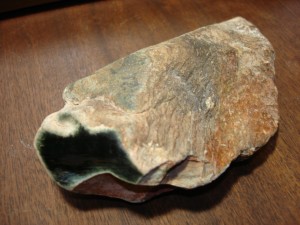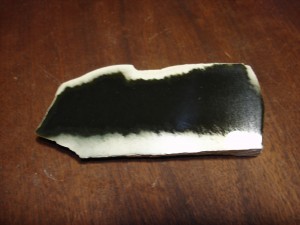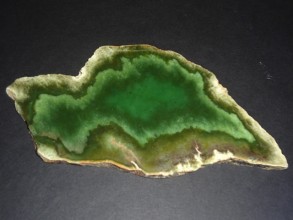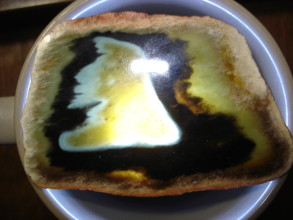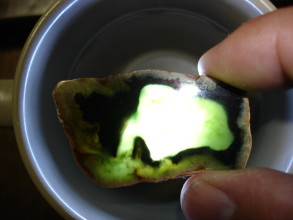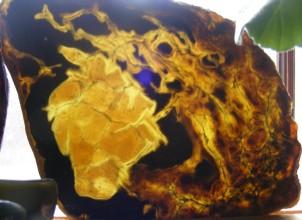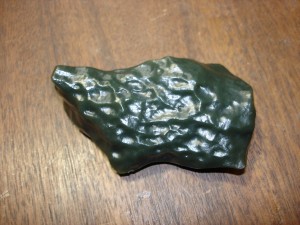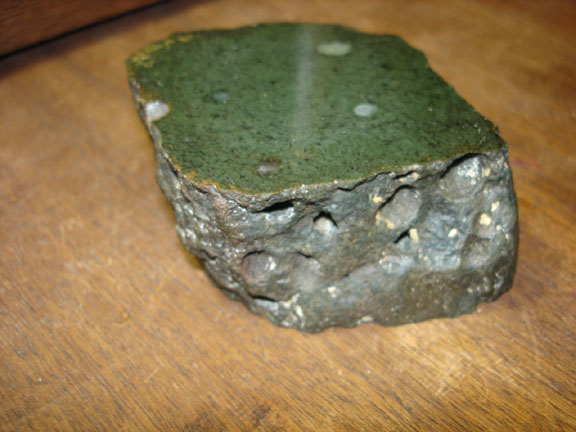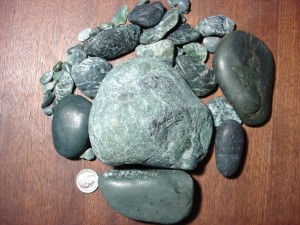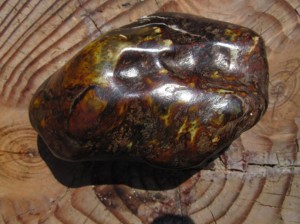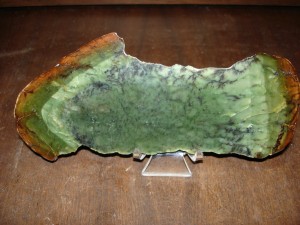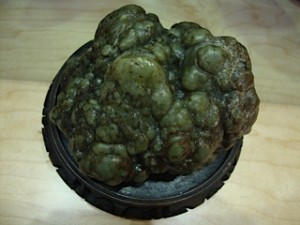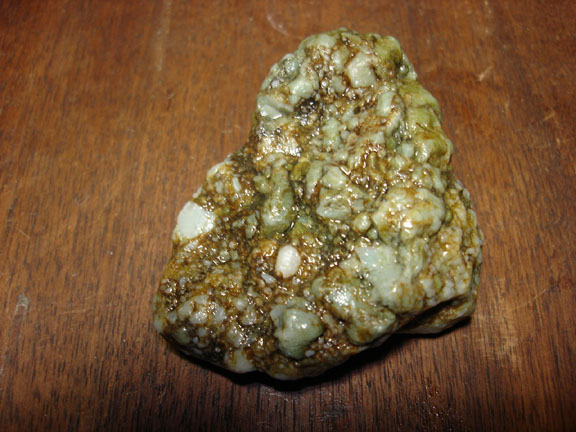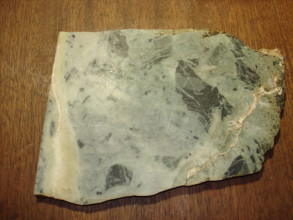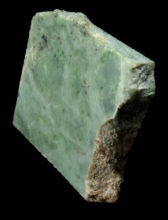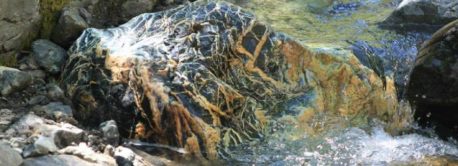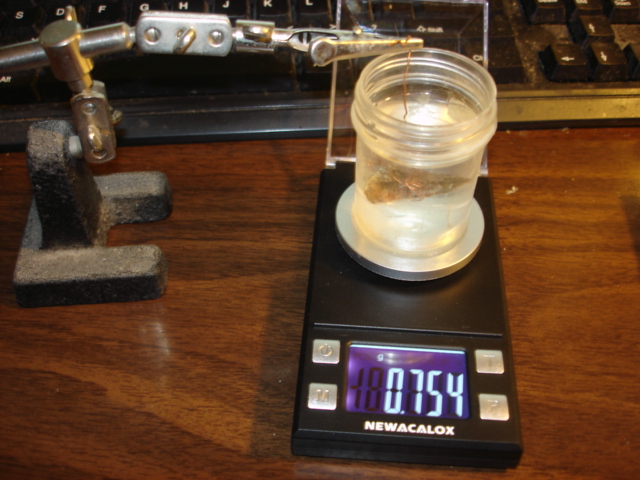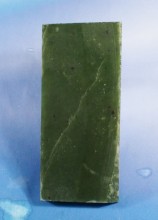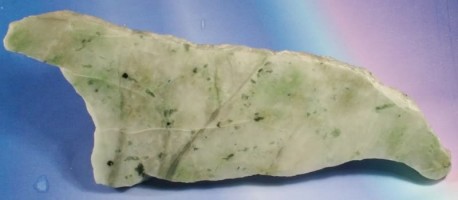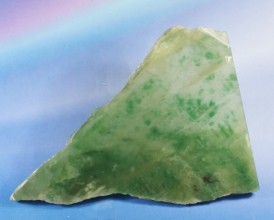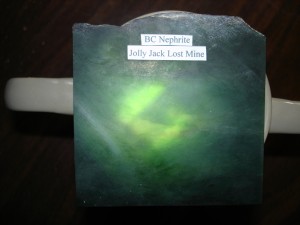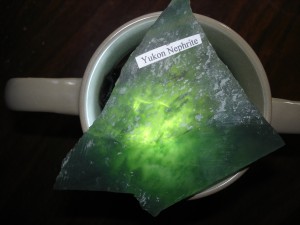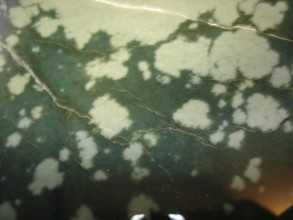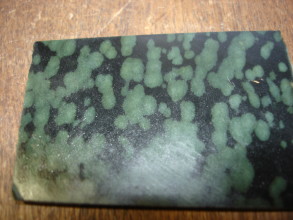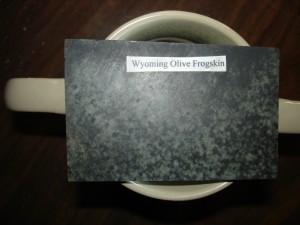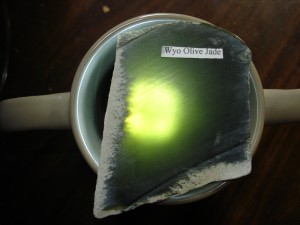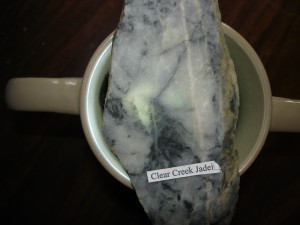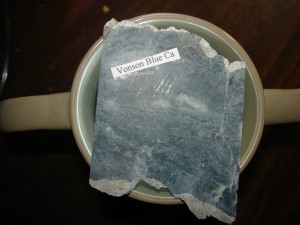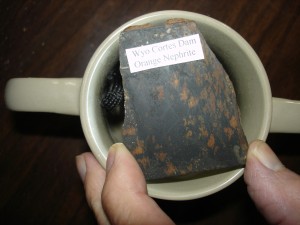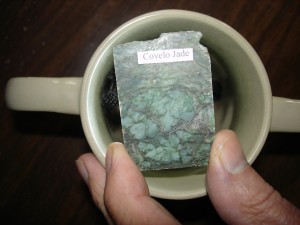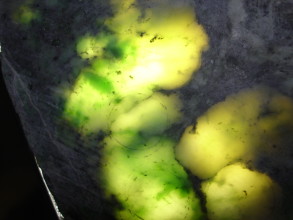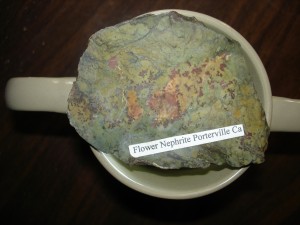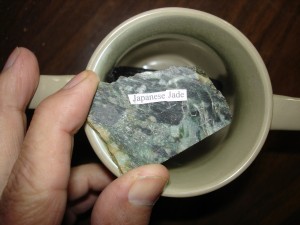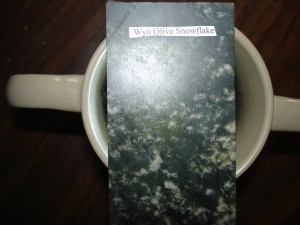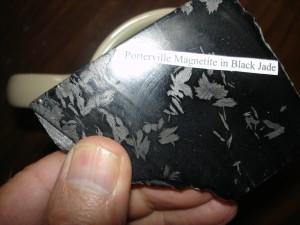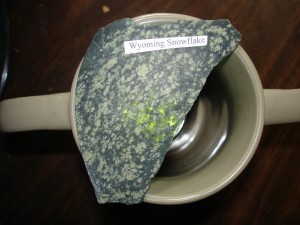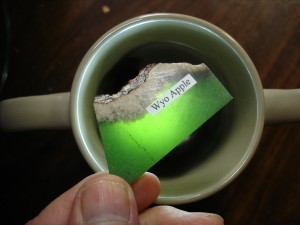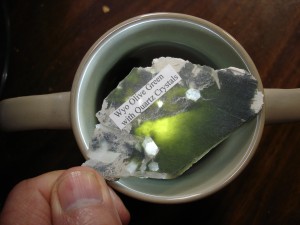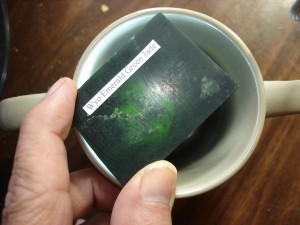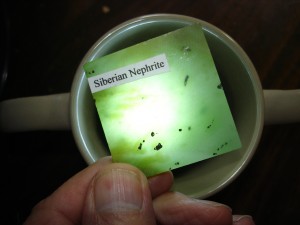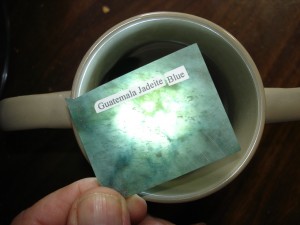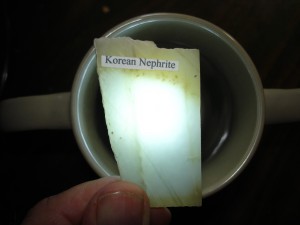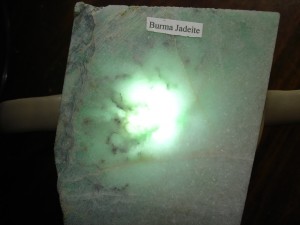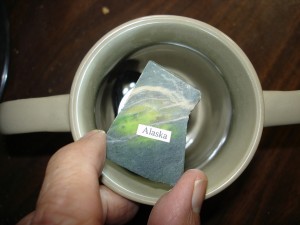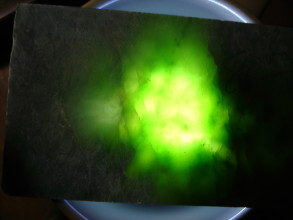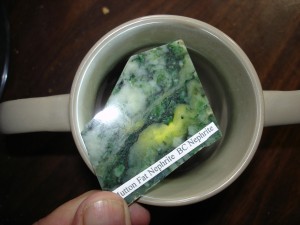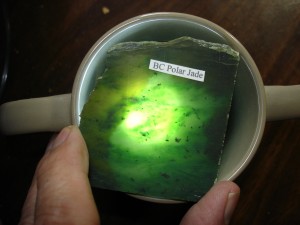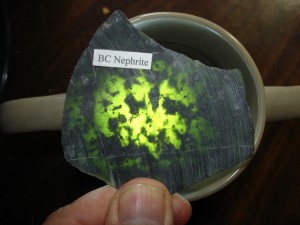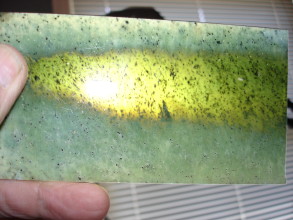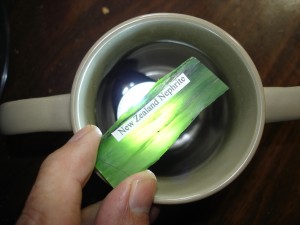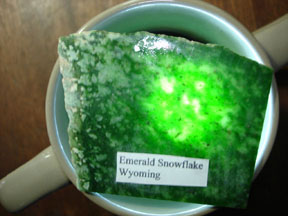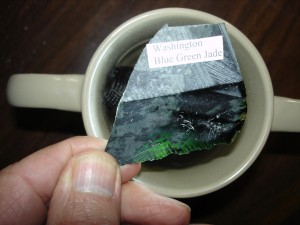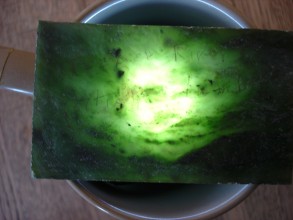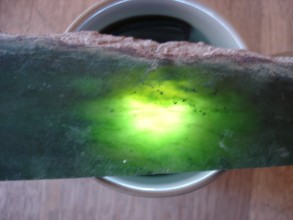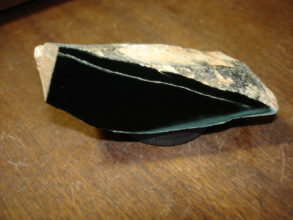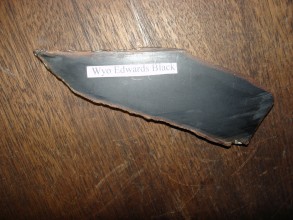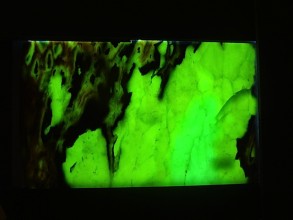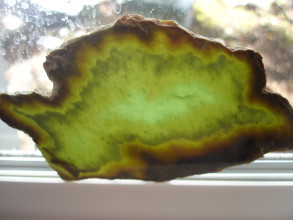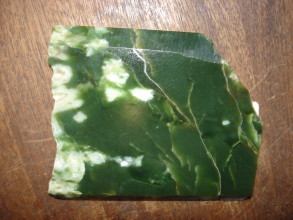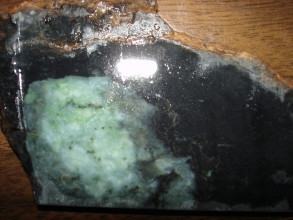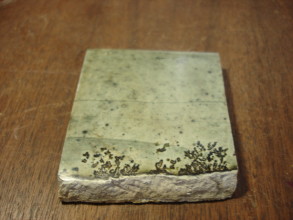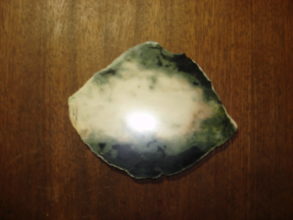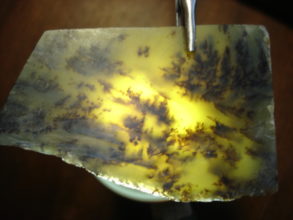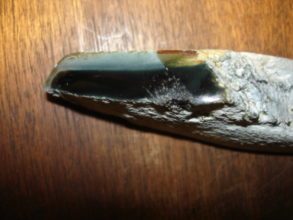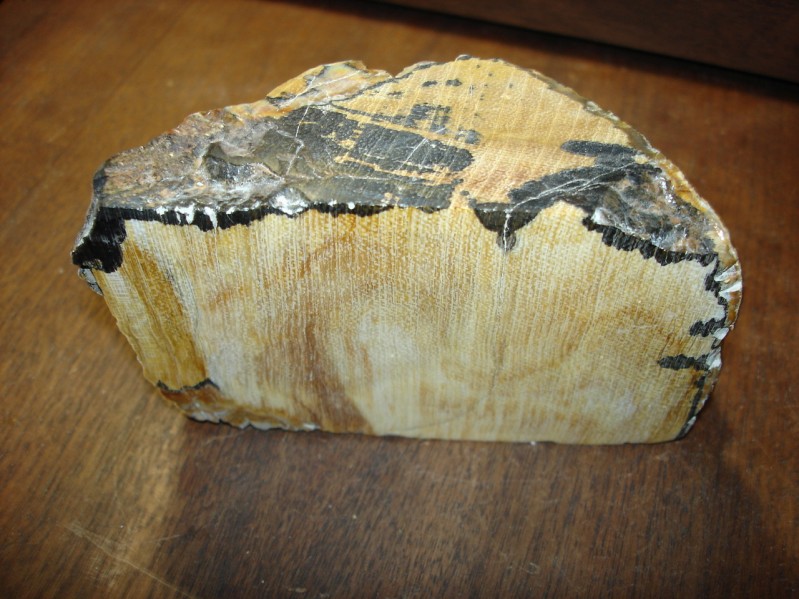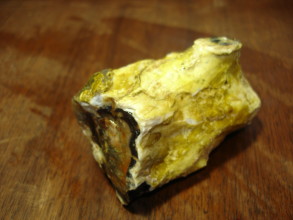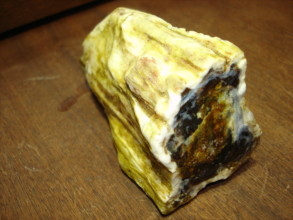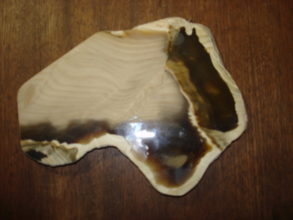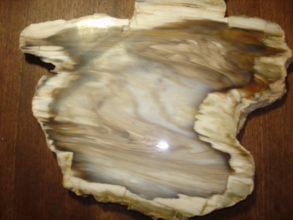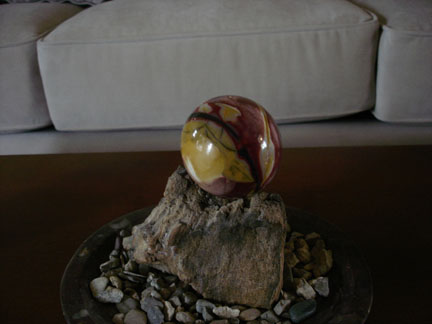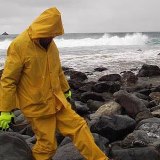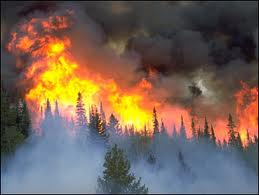Jade Ways Illustrated
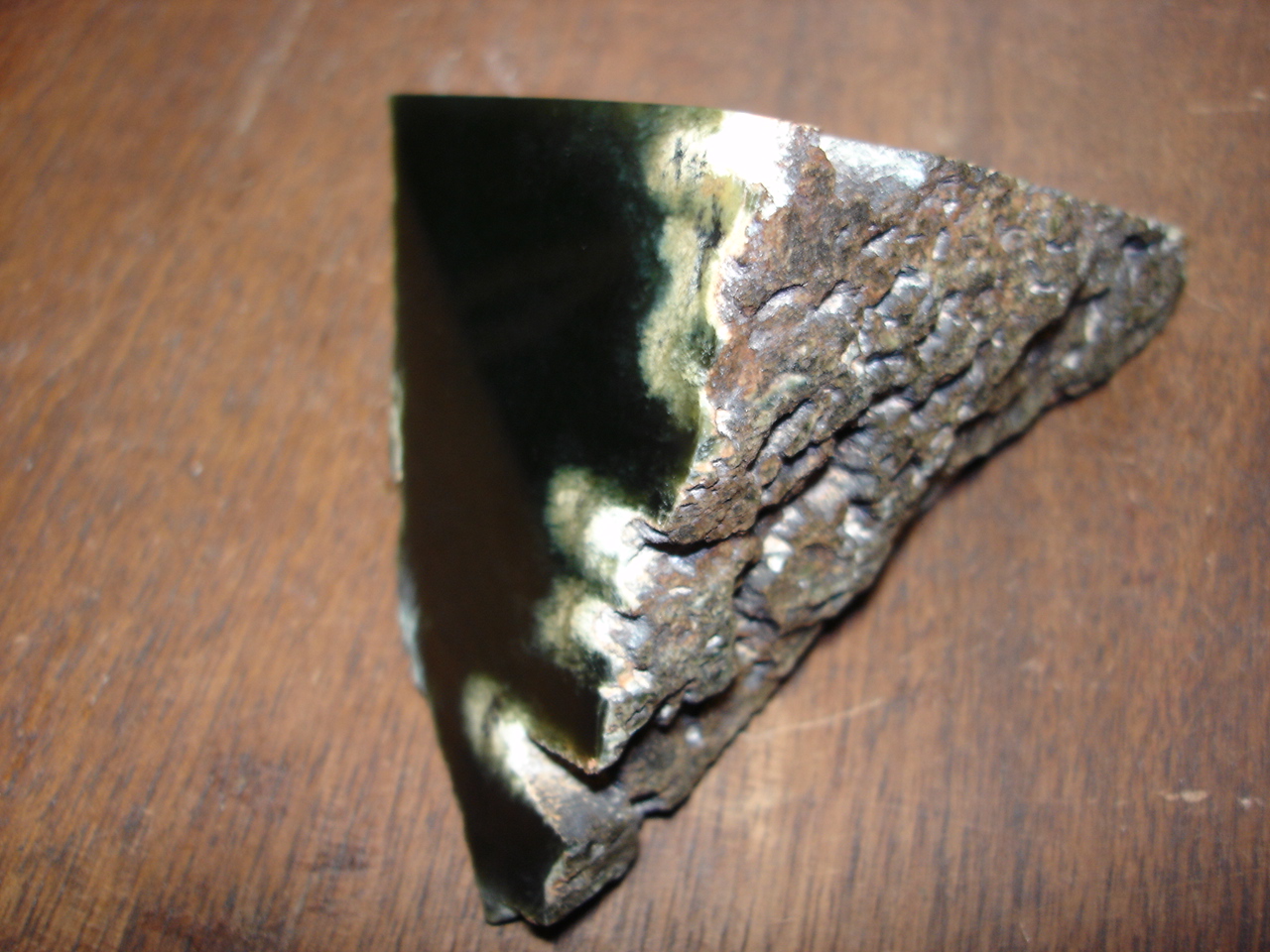
BY JAY E. BATES
WYOMING JADE
Out on the Wyoming plains lies a weather worn piece of “cinder jade” deeply etched by cold dry driven ice and sand and rock numbing cold. Yet under the rough brown blackened deep-pitted rind lies a beauty of unimagined luminosity and enduring radiance, cold to the touch as if forever marked by the eons of driven snow and cold. The green luminosity belies an inner toughness of no other comparable stone. The toughness is interwoven into the very fiber beaten upon earth’s anvil of tectonic forces, then through erosion, exposed to the surface to endure one of the harshest climates on the planet. Thus is produced one of the finest known nephrites, treasured by many and admired by more than a few.
The formation of Wyoming nephrite has been best described by the Wyoming Geological Society as follows:
“Nephrite, a product of metasomatism and alteration, occurs as sheets, lenses, and nodules along or near contacts between dissimilar rock types in strongly metamorphosed zones (Sinkankas, 1959). It also occurs in or adjacent to faults and fault zones. Nephrite in Wyoming is found within granitic gneisses and granites where enclosing or intruding amphibolites have been altered. Sherer (1969) investigated nephrite jade in Wyoming and suggested that it developed from metasomatic alteration of amphibole during metamorphism. Disrupted blocks of amphibolite became trapped as xenoliths in quartzofeldspathic gneiss, and were subsequently altered to nephrite by fluids derived from regional amphibolite-grade metamorphism. Amphibole, primarily hornblende, reacted with hot metamorphic fluids to produce actinolite (nephrite jade), clinozoisite, and chlorite. In the Laramie Range, this alteration was concentrated along shear zones and fractures where it resulted from the emplacement of quartz diorite, vein quartz, or pegmatite. Water loss at sites of nephrite development stopped the alteration process that otherwise would have eventually converted nephrite into serpentine. Wallrock alteration accompanied nephrite development, bleaching leucocratic granite-gneiss adjacent to the jade to produce a mottled pink and white granite-gneiss halo with associated secondary clinozoisite, pink zoisite, epidote, chlorite, and white plagioclase pervasively altered to mica (Hausel and Sutherland, 2000).”
Double click twice photographs to super-size to see details:
BELOW: Wyoming Jade Rind
BELOW: Wyoming Jade with White Rind
BELOW: Wyoming Bull Canyon Patterned Nephrite
Once formed, nephrite jade is much more resistant to erosion than its enclosing rocks, and is often found in residual and alluvial deposits as rounded boulders and cobbles. Alluvial jade tends to be solid, flaws and weak or impure zones having been removed during erosional processes. Because of nephrite’s durability, cobbles and boulders often survive transport over great distances from their source. They may also take on a natural polish from fluvial abrasion and from wind-driven sand in desert areas such as the Granite Mountains. Naturally polished pieces of nephrite jade exhibit a high-gloss, waxy surface and are known as jade slicks (Hausel and Sutherland, 2000). When not in the form of slicks, nephrite pieces may be covered with a cream to reddish brown oxidized weathering rind that hides the jade’s true color. Experienced jade prospectors learn to recognize this weathered surface, and can often recognize jade that others have overlooked.”
BELOW, LEFT: Wyoming Jade Slick
Sometimes the relentless driving Wyoming wind and sand, cold and hot freezing and thawing cycles, can carve out the less durable inclusions in the nephrite such as quartz crystals. Wyoming nephrite is the only jade that I am aware that often has quartz crystals included. Below is a quartz crystal included piece of Wyoming Cinder Jade where the wind and sand and extreme temperatures has eroded out the quartz crystals leaving cinder jade:
BELOW: Wyoming Cinder Nephrite (Also see Featured Jade at top of post)
The white spots on the sawn and polished surface of the nephrite are the tops of quartz crystals.
The 1930s and 1940s were the “glory days” of jade hunting in Wyoming. Many sources cite 1936 as the year of nephrite discovery near Lander, most likely by sheep herders. From 1936 until 1945, nephrite hunting was principally done by Wyoming residents as tough as the jade they sought. The end of World War II plus a 1945 article in Popular Science titled “Green Gold of Wyoming” changed all that. Something akin to a gold rush was on in central Wyoming and competition for Wyoming jade became intense. Some 7,000 to 8,000 pounds of jade were collected during the summer of 1945 alone. The link to gold was not unfounded. Famed Wyoming jade hunter Allan Branham once stated that “…jade lures and lures as no other stone. It is as bad as the gold fever, and once entangled with jade one seldom recovers.”

CALIFORNIA JADE
While a jade rush was on in Wyoming, things were pretty quiet in California, although some of the state’s mineral clubs were quietly collecting nephrite and jadeite throughout the state. One of the locations was Jade Cove and the adjacent coves near San Simeon on the Monterey Coast. Jade Cove was originally discovered by E. S. Parmalee of Palo Alto around 1941 and rediscovered by others in 1947 and henceforth was a well known destination of amateur mineral and lapidary societies of the state for jade collecting. During the 1960s and 1970s rockhounds and divers, and sometimes rockhounds who were also divers began diving and searching for nephrite at Jade Cove. One of those divers who was a record free diver and dove many times for jade at Jade Cove is Harry White who is well-known as The San Francisco Gem and Mineral Societies primary field trip leader and faceting instructor. Here is a youtube clip by Mike Burkleo discussing his involvement with jade and his diving for jade at Jade Cove California: https://www.youtube.com/watch?v=VFUKs4jA5co
The word was soon out about some of the fine nephrite being found and quite a few people were soon scramble and digging for jade all over the beaches and cliffs. When things got out of hand with winches and dynamite, rules were imposed to allow only digging within the tidal zone and restricted methods of removal from the ocean. Monterey jade comes in many shades including blue, but most are a dark green shading to black.
BELOW, Jade Cove Nephrite
Big Sur Vulcan jade is a favorite rare type of nephrite found near Jade Cove. This jade naturally erodes out of the ancient seabed having been thrust up about 200ft above sea level by colliding tectonic plates. This ancient seabed is loaded with serpentine and jade materials that have been sitting in the iron rich soil for millennia. Nephrite jade is very porous and iron rich waters “stains” the exterior the jade with vibrant orange, reds, yellows and browns shading into green towards the center, sometimes with dendrites of presumably manganese oxide.
BELOW: Vulcan Jade
BELOW: Vulcan Jade Slab (Note zones of staining)
Most of the nephrite and jadeite found in California comes from the coastal ranges and the metamorphic zones created by massive plate tectonics where the Pacific plate is being subducted below the North American plate. During this process, quite a bit of pressure and some heat can occur in the presence of super-hot mineral rich water. When conditions are right, the two types of jade may form, nephrite and jadeite.
Sometimes slow cooling grape-like structures are formed in the jade to create Botryoidal Jade which is highly prized by collectors for its visual appeal.
BELOW: Jade Cove Botryoidal Jade
Within San Benito County in the Clear Creek Area is found a jadeite. Usually a jadeite will exhibit a crystal structure within, and such a crystal structure is evident in most Clear Creek Jadeite. Clear Creek Jadeite is generally not as a fine of a quality as some of the jadeites found in Burma and Guatemala, although it was been reported that Clear Creek jadeite is purer than the jadeite from Burma.
BELOW: Clear Creek Jadeite
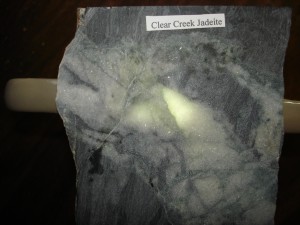
Jadeite along with nephrite has also found up near Covelo in Mendocino County, California. Over the years, the San Francisco Gem and Mineral Society and other clubs have had many field trips to the Covelo area to look for jade. Quite a number of nice pieces of nephrite and green and white diopsidic nephrite have been found, some of it botryoidal. Jadeite has been found in the past near Covelo by the California Division of Mines and Geology as described in their “Special Report 10-C (September 1951)”. However, I have had several pieces of jade from Covelo spectographically tested by Vic Showell of Washington and much of which was thought to be jadeite tested out as hydrogrossular garnet and vesuvianite. Some did test as diopsidic nephrite.
BELOW: Botryoidal Nephrite from Covelo
BELOW: Jadeite from near Covelo, specific gravity 3.25 Blands Peak Taliaferro Ridge east of Leech Lake
CALIFORNIA LOCATIONS FOR JADE
Occasionally jade, mostly nephrite has been reportedly found in the following California locations: 1. South fork of Indian Creek. 2. Clear Creek above Klamath River.. 3. Klamath River. 4. Trinity River. 5. North fork of Trinity River. 6. South fork of Trinity River. 7. Along surf-line of Pacific from Patricks Point to Dry Lagoon. 8. Van Dusen River . 9. Mad River. 10. North fork of Elder Creek. 11. Williams Creek. 12. North fork of Eel River. 13. Blue Banks on Estel Ridge. 14. Middle Fork of the Eel River. 15. Main Eel River. 16. Feliz Creek. 17. Russian River. 18. North fork of Cache Creek. 19. Big Stony Creek. 20. Big Stony Creek tributaries. 21. Hyphus Creek. 22. West branch of the North Fork of the Feather River. 23. Concow Lake watershed. 24. Feather River across from Pulgas. 25. Valley Ford. 26. Massa Hill 27. Angel Island. 28. Mt Diablo. 29 Stifle Memorial Claim. 30. American River. 31. Fly Away Gulch. 32. David Gulch. 33. Clear Creek. San Benito County. 34. Jade Cove Monterey County. 35. Cape San Martin. 36. Leffingwell Creek. 37. Salinas River. 38. Lewis Hill north of Porterville. 39. South slope of Figueroa Mt. near Los Olivos. 40. Mohave River near Victorville. 41. Eagle mts. outside Joshua Tree Nat. Mon.
Caution, many of the above locations are on private lands and parks and are not available for collecting. Caution is advised to anyone using this list to look for jade. For instance the jade supposedly found at Concow Lake is most likely basanite, a fine grained black basalt or jasper that will take a good polish.
Also if you do find something it may or may not be considered jade without at least testing for hardness and specific gravity. Without testing for at least hardness and specific gravity whatever you find should not be sold as jade.
GENERAL
Jade is a difficult gemstone to absolutely identify without expensive tests. Almost always it is found in known locations where it has been previously found. You can usually do a scratch test with a knife blade for nephrite. Nephrite has a hardness of 6.5. If it scratches with ordinary steel, it is not nephrite, probably serpentine; the exception being some of the Mariposa County nephrites that contain talc. Quartz or chalcedony will scratch nephrite. If quartz or chalcedony doesn’t scratch your potential nephrite, it is not nephrite. If it doesn’t scratch with an ordinary knife blade, but does scratch with a quartz crystal, it could be nephrite. Then you should test your potential nephrite for specific gravity.
Many times testing for specific gravity also helps to identify jade. Jadeite has a specific gravity of 3.34. Nephrite has a specific gravity of usually 2.95, (with a range between 2.90 and 3.02).
Specific gravity of a rock is the weight of a rock divided by the weight of water displaced by the rock. An easy way to get the specific gravity of a rock is to weigh it, then place a container of water with the wire to suspend the jade in the water on your scale and turn it on again so it is zeroed in, then reweigh your rock suspended in the water on the wire. I use a old cut down plastic film can as my container. Any thin wire or thread will do as you are only weighing the water displaced by the wire not the wire. I use a rather inexpensive scale (NEWACALOX) that will weigh up to 100 grams with an accuracy of .001 grams. Make sure the rock or wire does not touch the sides or bottom of the container and the rock is completely under water. Tap the suspending device to see if the weight measurement changes. If it does, your rock is touch the sides or bottom. Test using a small piece of known nephrite until you are comfortable with what you are doing and get the right reading. This methodology is quite useful when you can use a small piece of suspected jade to test for specific gravity without having to break apart a large visual specimen for testing.
Another method of testing for specific gravity is to use a fish weighing scale that weighs things hanging from the scale. I use a $20 “Fishfun” scale that weighs to 110 pounds with an accuracy of .005 pounds. Using this method, specific gravity is the weight of your rock / weight of the rock minus the weight you got of the rock suspended in a bucket of water from your fish weighing scale.
Here is a photograph of one of my tests for specific gravity, testing for jade.
There may be some jade somewhere that is magnetic, but if a magnet sticks to your rock, you can assume it is not jade. The magnetite in Stoddard Wells black nephrite is magnetic, but not the nephrite. It needs to be remembered that jade is a rock, not a mineral, and other minerals beyond the jade forming minerals can also be present. Often these other minerals contribute to the jades visual qualities and the uniqueness of the various recognized varieties of jade.
Nephrite will usually produce a milky white residue slurry when cut by a diamond saw or wheel. Nephrite will not fluoresce. Light green jadeite will show pale white under LW. Sometimes a weak green or yellow will appear.
For the last couple decades the best jade, mostly nephrite such as Polar and Ogden Jade has been coming from British Columbia. Other fine nephrites have been found in Siberia. Recently, quite a bit of jadeite has been coming from Guatemala, including a beautiful blue jadeite. As always, Burma still remains an active source for quality jadeite. The state of Washington also has been a recent hotbed for discovering jade. Wyoming nephrite remains a favorite of most jade collectors.
Here is picture of some nephrite from Mariposa County California.
This is not jade it is grossular garnet from the Feather River California. Specific gravity 3.6, hardness 7-7.5.
Here is some more non-jade, idocrase or californite, from Happy Camp California. Specific gravity 3.32-3.43, hardness 6.5.
I consider Happy Camp idocrase and the Feather River grossular garnet to be better lapidary material than many lower quality jades. Chalcedony another possible impostor has a specific gravity of 2.6-2.7. Basanite has a specific gravity of around 2.95, very near nephrite, making it difficult to distinguish it from black nephrite.
IMAGE GALLERY
As an aid in identifying some of the more common types of jade the rockhound or lapidary is likely to encounter we have assembled some backlit photographs showing the internal structure, color and translucency of some of our jades. I was helped by Bob Kozak former president of the San Francisco Gem and Mineral Society to identify various locations for the jades that were not already identified. Many of my better nephrite examples were obtained from Mike Burkleo and Rodger Merk.
DOUBLE CLICK TWICE TO DOUBLE SIZE. RETURN ARROW TO RETURN TO REGULAR SIZE.
British Columbia Nephrite
Yukon Nephrite (Cassiar)
Wyoming Frogskin Nephrite
Another Wyoming Frogskin
Wyoming Olive Frogskin
Wyoming Olive Nephrite
Clear Creek Jadeite
Clear Creek Jadeite
Vonson Blue Nephrite California
Wyoming Cortes Dam Orange Nephrite
Covelo Nephrite
Covelo Nephrite
Flower Nephrite Porterville Ca.
Japanese Nephrite
Wyoming Olive Snowflake Nephrite
Stoddard Wells Ca. Magnetite in Black Nephrite
Wyoming Snowflake Nephrite
Wyoming Apple Green Nephrite
Wyoming Olive Green Nephrite with Quartz Crystals
Wyoming Emerald Green Nephrite
Siberian Nephrite
Guatemala Blue Jadeite
Korean Nephrite
Burma Jadeite
Alaska Nephrite
Alaska nephrite
British Columbia Nephrite
British Columbia Polar Nephrite
This is what I believe is a magnetic nephrite as it the right hardness and specific gravity to be a nephrite and is slightly magnetic. I assume ferric dark inclusions. British Columbia Nephrite
New Zealand Nephrite
New Zealand Nephrite
Emerald Snowflake Nephrite Wyoming
Washington Blue Green Nephrite
Frasier River Nephrite, BC Canada
Polar Nephrite BC
Edwards Black Nephrite white rind
Edwards Black red rind
Wyoming Bull Canyon Nephrite, from Bob Kozak Collection
Wyoming Bull Canyon Nephrite from the Dan Beck Collection
My Bull Canyon Nephrite from Bob Kozak
More of my Bull Canyon
Flower Nephrite from the Yukon
Fire Nephrite Feather River Ca.
Dendritic Nephrite from the Feather River and Howard Boots
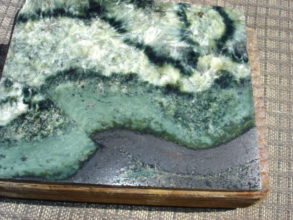
Ghost Nephrite from Nevada. Top half is Chatoyant Actinolite, middle is Nephrite, and the bottom is Magnetite.
Some white, green and slightly red nephrite of unknown origins. Probably from California.
Dendritic nephrite mostly likely from Wyoming similar to another from Wyoming owned by Dan Beck.
Jadeite from Leech Mountain Claim California.
Rare Wyoming nephrite with tourmaline sprays.
Petrified Wood
The following pictures are pieces of petrified wood in my collection. Those that I have personally collection are so noted with a story. Others, I purchased from the collection of others. The colors correspond to the trace minerals incorporated into the petrified wood: carbon-black, cobalt-green/blue, copper-green/blue, iron oxide-red, brown and yellow, manganese- pink/orange, manganese oxides- black/yellow.
This is a piece of Acacia wood from Auburn California. The identification was made by Walt Wright, a well known petrified wood expert from southern California. It is from a collection by Theo Steinhauser, long time member and president of SFGMS. 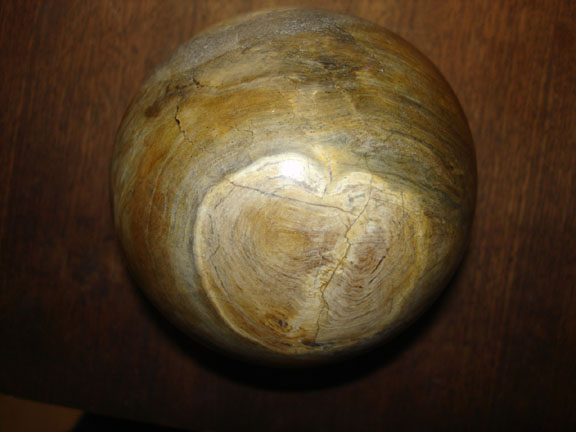 Here is a four inch sphere I made from a stump of Antioch Oak Wood from near Antioch California. It came off a ranch near Antioch that was since developed into a residential subdivision. I bought the stump off the rancher a few days before the bulldozers showed up.
Here is a four inch sphere I made from a stump of Antioch Oak Wood from near Antioch California. It came off a ranch near Antioch that was since developed into a residential subdivision. I bought the stump off the rancher a few days before the bulldozers showed up. 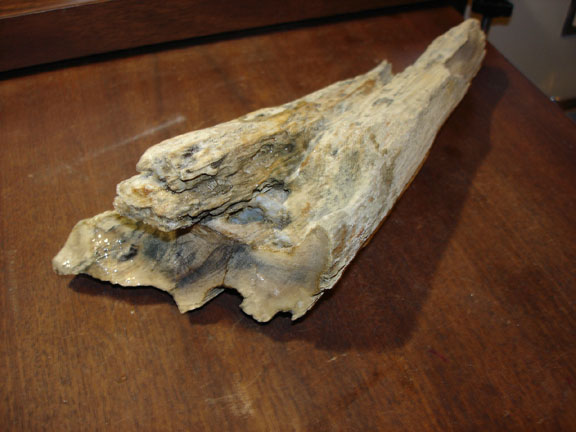 This is a piece of petrified wood from near Cedarville in the northeastern corner of California. I collected this interesting piece on a field trip with the Fossils for Fun club from Sacramento. There is plug of what appears to be near pure chalcedony in the center of the piece.
This is a piece of petrified wood from near Cedarville in the northeastern corner of California. I collected this interesting piece on a field trip with the Fossils for Fun club from Sacramento. There is plug of what appears to be near pure chalcedony in the center of the piece. 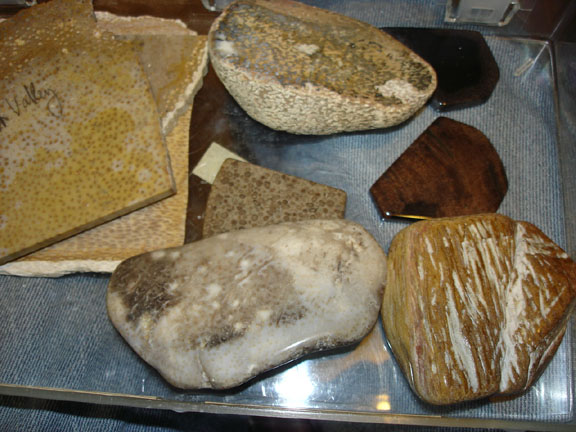 Pictured above are a number of pieces of petrified palm wood that are labeled as being from the Mohave Desert in California. I believe some of the slabs may be from Sperry Wash, Death Valley.
Pictured above are a number of pieces of petrified palm wood that are labeled as being from the Mohave Desert in California. I believe some of the slabs may be from Sperry Wash, Death Valley. 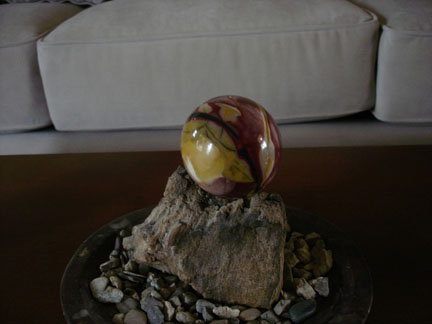 This small sphere of Australian jasper is resting on a Suiseki piece of petrified wood from the Black Rock Desert in Nevada. The Suiseki piece I collected on a field trip I led into the Black Rock.
This small sphere of Australian jasper is resting on a Suiseki piece of petrified wood from the Black Rock Desert in Nevada. The Suiseki piece I collected on a field trip I led into the Black Rock.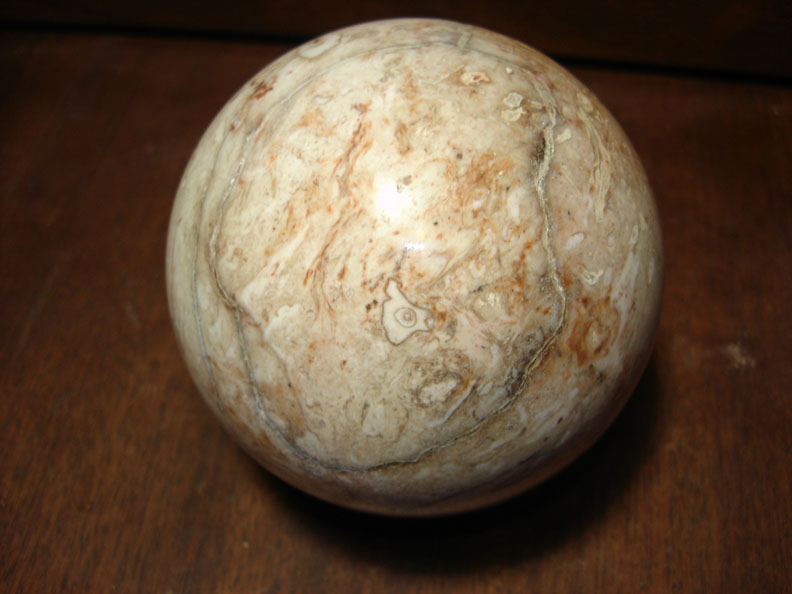 Palm Root Sphere-below
Palm Root Sphere-below 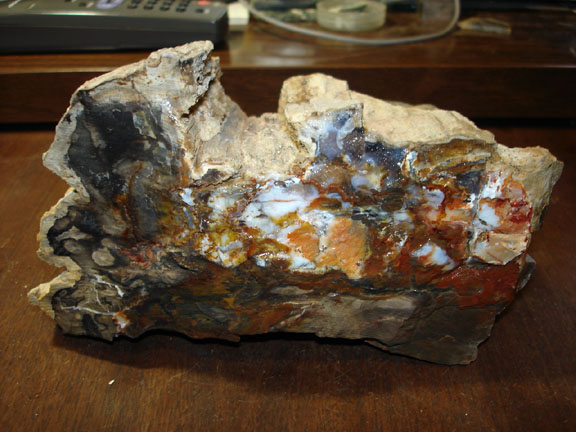 This is petrified wood from the Black Rock Desert in Nevada. This was collected by me along with Scott Paradis near the Lassen-Clapper murder site. Lassen, who is well known for the Lassen Cutoff to the California gold fields, was on a prospecting trip into the Black Rock looking for gold with Clapper and another man. They were bushwhacked at the murder site and Lassen and Clapper were killed and buried there. The other man escaped to tell his tale. I have often wondered if they did find gold and were killed by the survivor so he could keep all the gold to himself. Kinda, like Dobbs in “The Treasure of the Sierra Madre.” Scott is one of those souls you can count on that is up for a rock-hounding adventure anytime. On this trip I drove to the top of a steep hill in my Jeep in four wheel drive and Scott followed in his Ford pickup. I had loosened the rocks on my way up and he spun sideways and got stuck with rear end of his pickup up against a barb wire fence. Luckily with a couple of towing straps I was able to pull him from his predicament. We also crossed a wash with about two feet of water in the bottom without getting stuck.
This is petrified wood from the Black Rock Desert in Nevada. This was collected by me along with Scott Paradis near the Lassen-Clapper murder site. Lassen, who is well known for the Lassen Cutoff to the California gold fields, was on a prospecting trip into the Black Rock looking for gold with Clapper and another man. They were bushwhacked at the murder site and Lassen and Clapper were killed and buried there. The other man escaped to tell his tale. I have often wondered if they did find gold and were killed by the survivor so he could keep all the gold to himself. Kinda, like Dobbs in “The Treasure of the Sierra Madre.” Scott is one of those souls you can count on that is up for a rock-hounding adventure anytime. On this trip I drove to the top of a steep hill in my Jeep in four wheel drive and Scott followed in his Ford pickup. I had loosened the rocks on my way up and he spun sideways and got stuck with rear end of his pickup up against a barb wire fence. Luckily with a couple of towing straps I was able to pull him from his predicament. We also crossed a wash with about two feet of water in the bottom without getting stuck. 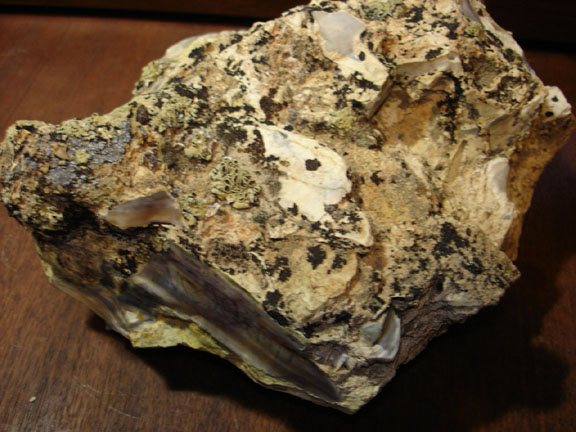 This is bog wood from near McDermitt Nevada. I found this on a trip with my two brothers, Lee and Scott. We also found Gary Green Jasper and a lot of plain pieces of petrified wood. On this trip Scott and I went from Winnemucca to Gerlach via Sulfur, camping at a hot springs near Gerlach then headed north from Gerlach through Soldier Meadows and Summit Lake ending up at Virgin Valley Camp for more soaking in a hot springs before spending the next night at White Horse Hot Springs in Oregon. Scott got out his harmonica and played a few blues numbers to entertain me and some uninvited coyotes that joined in. After a couple beers and soaking in the hot springs and enjoying the nighttime sky, even the coyotes didn’t sound too bad.
This is bog wood from near McDermitt Nevada. I found this on a trip with my two brothers, Lee and Scott. We also found Gary Green Jasper and a lot of plain pieces of petrified wood. On this trip Scott and I went from Winnemucca to Gerlach via Sulfur, camping at a hot springs near Gerlach then headed north from Gerlach through Soldier Meadows and Summit Lake ending up at Virgin Valley Camp for more soaking in a hot springs before spending the next night at White Horse Hot Springs in Oregon. Scott got out his harmonica and played a few blues numbers to entertain me and some uninvited coyotes that joined in. After a couple beers and soaking in the hot springs and enjoying the nighttime sky, even the coyotes didn’t sound too bad. 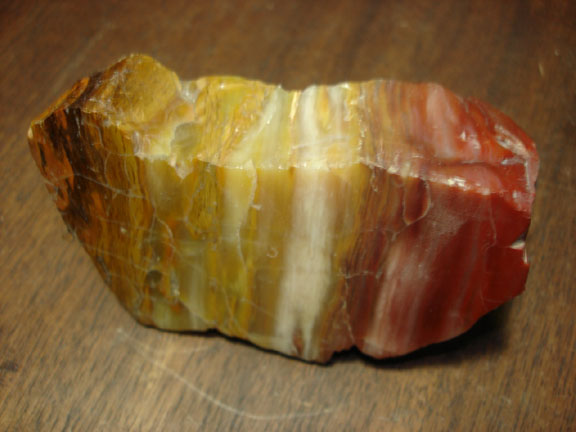 Colorful opalized wood from near McDermitt Nevada.
Colorful opalized wood from near McDermitt Nevada. 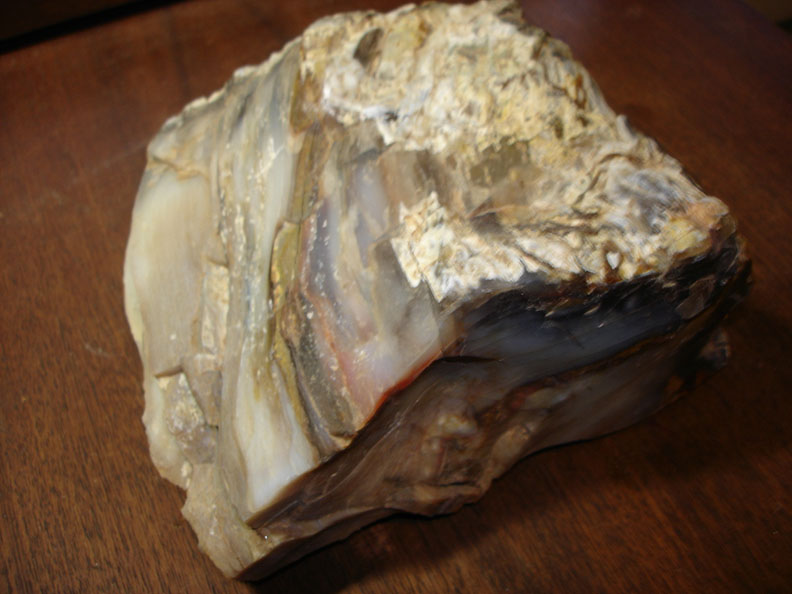 This is a piece of colorful wood I collected from Hubbard Basin Nevada. The Boise rock club was there digging when I arrived at Hubbard Basin. One of their members graciously let me dig in his hole after he was finished for the day, where I found this piece and the next piece. The BLM later filled in all the holes and when I went back in later years I did not find any more nice pieces even though I dug down a couple feet. I know there are more nice pieces of petrified wood there and maybe some day I will dig down about four feet to them in that glory hole.
This is a piece of colorful wood I collected from Hubbard Basin Nevada. The Boise rock club was there digging when I arrived at Hubbard Basin. One of their members graciously let me dig in his hole after he was finished for the day, where I found this piece and the next piece. The BLM later filled in all the holes and when I went back in later years I did not find any more nice pieces even though I dug down a couple feet. I know there are more nice pieces of petrified wood there and maybe some day I will dig down about four feet to them in that glory hole. 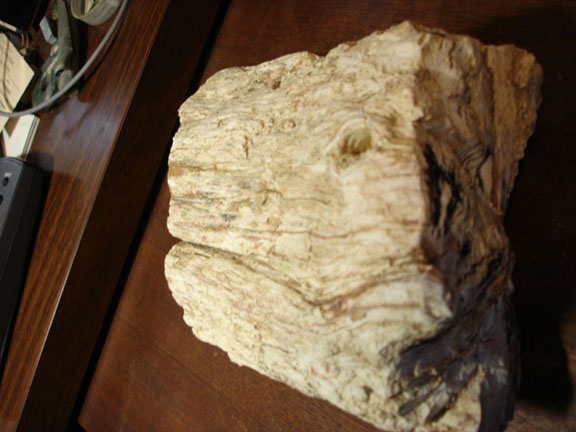 More Hubbard Basin Wood I collected. Note the great knothole in this piece.
More Hubbard Basin Wood I collected. Note the great knothole in this piece. 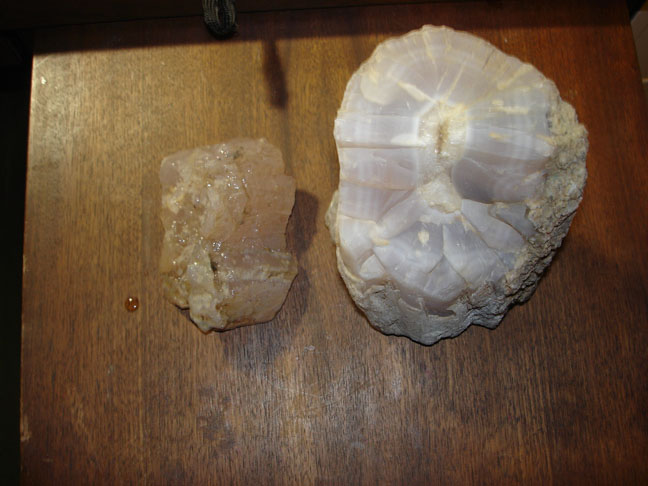 Pink limb casts from Texas Springs Nevada. I camped there in the middle of fire season and was worried that if there was a fire I might be trapped. I later found out I could have gotten out by heading in the opposite direction I came in from.
Pink limb casts from Texas Springs Nevada. I camped there in the middle of fire season and was worried that if there was a fire I might be trapped. I later found out I could have gotten out by heading in the opposite direction I came in from. 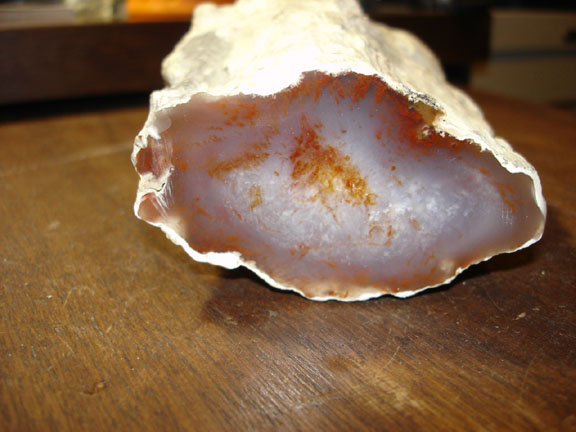 From the Little Humbolt River near the Ash Chimney Creek Reservoir, Nevada
From the Little Humbolt River near the Ash Chimney Creek Reservoir, Nevada 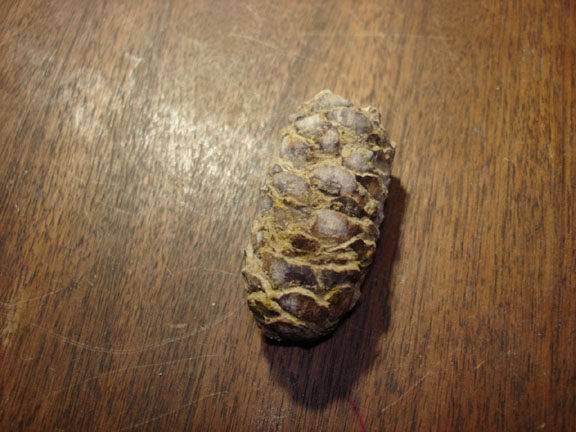 This is a petrified spruce cone from the Virgin Valley Rainbow Ridge Precious Opal Mine that my brother Lee found when we shared a front end loader load of material from the pit. Lee found this one and another that is likely to contain precious opal. We have never cut any of them open to see if they do contain precious opal. This one is in my collection.
This is a petrified spruce cone from the Virgin Valley Rainbow Ridge Precious Opal Mine that my brother Lee found when we shared a front end loader load of material from the pit. Lee found this one and another that is likely to contain precious opal. We have never cut any of them open to see if they do contain precious opal. This one is in my collection. 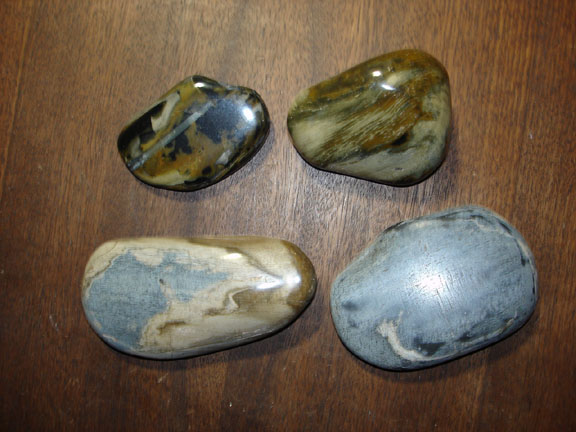
Here is some myrtle wood from the Seven Devils Beach, Bandon Oregon. In California we call myrtle wood, California bay laurel. It is the same tree. It is surprising how little trees have changed over the millennium. So little, that we can use books for identifying existing trees to identify species of petrified wood. I was given these by Joyce Dunn. 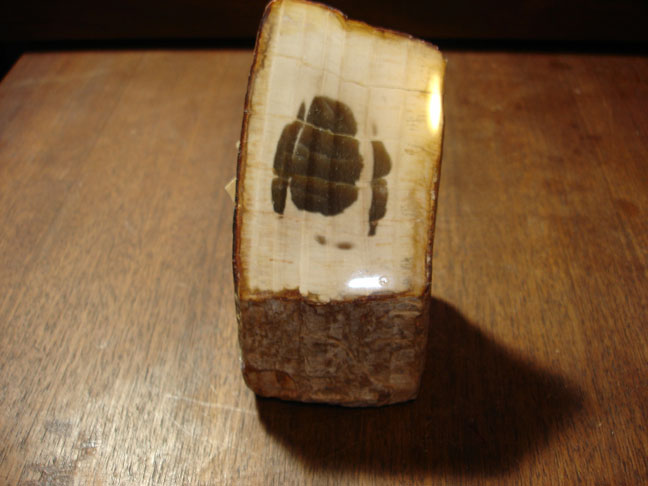 This is another specimen from the Steinhauser collection. Theo labeled it “Pedocarpus Genus:Pedocarpus, Family: Pedocarpaceae, Loc: Linn County Oregon, Geological Age: Oligocene, Geologic Formation: Little Butte”. That is another way of saying it is from a pine tree that is 25 million to 40 million years old located at Little Butte in Linn County Oregon.
This is another specimen from the Steinhauser collection. Theo labeled it “Pedocarpus Genus:Pedocarpus, Family: Pedocarpaceae, Loc: Linn County Oregon, Geological Age: Oligocene, Geologic Formation: Little Butte”. That is another way of saying it is from a pine tree that is 25 million to 40 million years old located at Little Butte in Linn County Oregon. 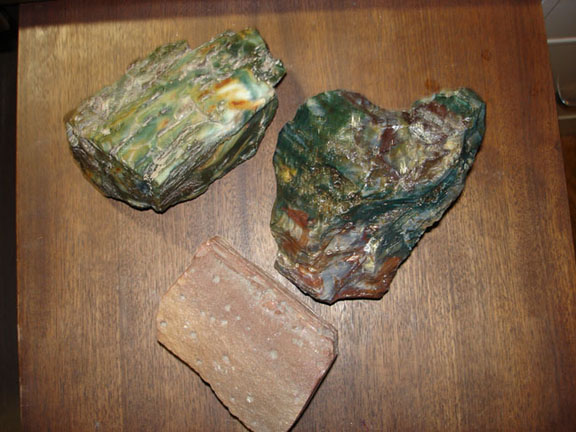 This is petrified wood from Hampton Butte, Oregon. It takes an excellent polish and is highly prized for lapidary work, particularly the green colored material. The bottom piece exhibits worm holes. I collected this either on a trip with my brother Lee, or my club, SFGMS.
This is petrified wood from Hampton Butte, Oregon. It takes an excellent polish and is highly prized for lapidary work, particularly the green colored material. The bottom piece exhibits worm holes. I collected this either on a trip with my brother Lee, or my club, SFGMS. 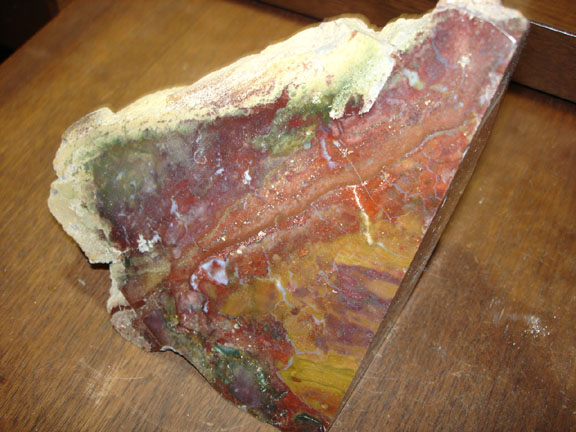 This is a piece of Marston replacement wood. My brother Lee and I went to the Marston Ranch to get some of this material. Mr Marston, the ranch owner, was in the pit with his crawler tractor digging out material for the Rockhound Pow Wow, of which we belonged. For some reason, I would guess there was a better dig on another ranch, we were the only ones there. We spent some time discussing haying, cows, and other things ranch related with Mr Marston. He gave me a large piece of the wood he had just dug out, of which this is a piece. The Pow Wow trips to the ranches around Madras Oregon twenty years ago were really productive for great material.
This is a piece of Marston replacement wood. My brother Lee and I went to the Marston Ranch to get some of this material. Mr Marston, the ranch owner, was in the pit with his crawler tractor digging out material for the Rockhound Pow Wow, of which we belonged. For some reason, I would guess there was a better dig on another ranch, we were the only ones there. We spent some time discussing haying, cows, and other things ranch related with Mr Marston. He gave me a large piece of the wood he had just dug out, of which this is a piece. The Pow Wow trips to the ranches around Madras Oregon twenty years ago were really productive for great material. 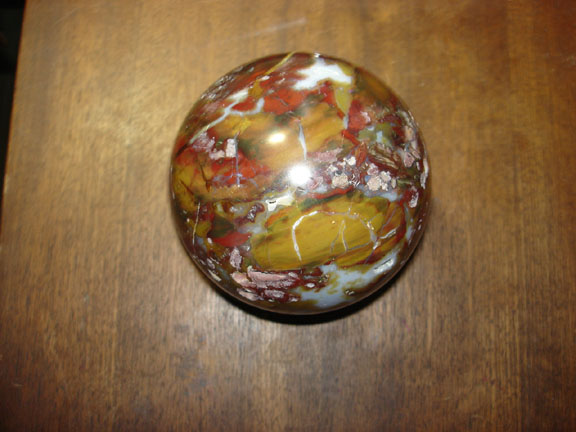 This is a four inch sphere I made from another piece of Marston replacement wood I collected on a later trip with the SFGMS club of which I am a member.
This is a four inch sphere I made from another piece of Marston replacement wood I collected on a later trip with the SFGMS club of which I am a member. 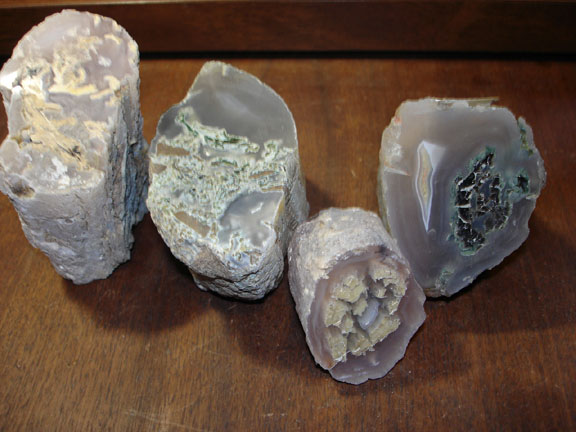 These are limb casts I collected from near Paulina Oregon. I have been there four or five times to collect this outstanding petrified wood. The middle piece standing up is the first piece I collected there with my brother Lee. Contrary to the tall tale Lee tells that I stepped on his hand to keep him from grabbing it first after it was unearthed, I unearthed it on my side of the hole and he did not have a chance to grab it.
These are limb casts I collected from near Paulina Oregon. I have been there four or five times to collect this outstanding petrified wood. The middle piece standing up is the first piece I collected there with my brother Lee. Contrary to the tall tale Lee tells that I stepped on his hand to keep him from grabbing it first after it was unearthed, I unearthed it on my side of the hole and he did not have a chance to grab it. 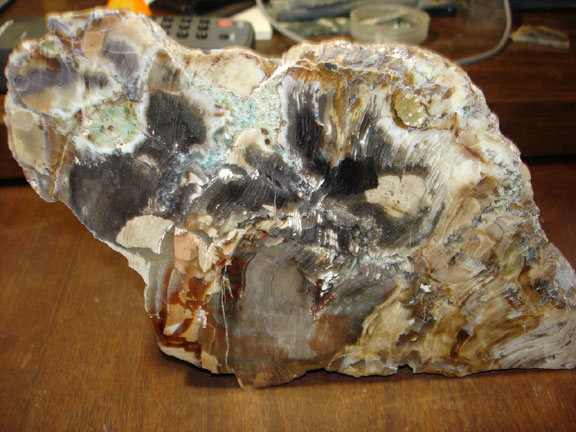 This is a slab of a chunk of a log Lee did dig up at Paulina. I got a slab of it for cutting and polishing it for him. It does contain some of the green agate that Paulina Limb Casts are noted for.
This is a slab of a chunk of a log Lee did dig up at Paulina. I got a slab of it for cutting and polishing it for him. It does contain some of the green agate that Paulina Limb Casts are noted for. 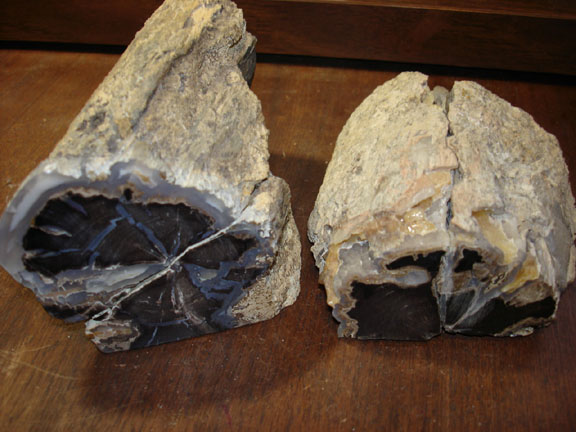 This is some of the Blue Forest wood I collected from near Farson. We always stop at Farson for some great ice cream as do most Wyomingites traveling through.
This is some of the Blue Forest wood I collected from near Farson. We always stop at Farson for some great ice cream as do most Wyomingites traveling through. 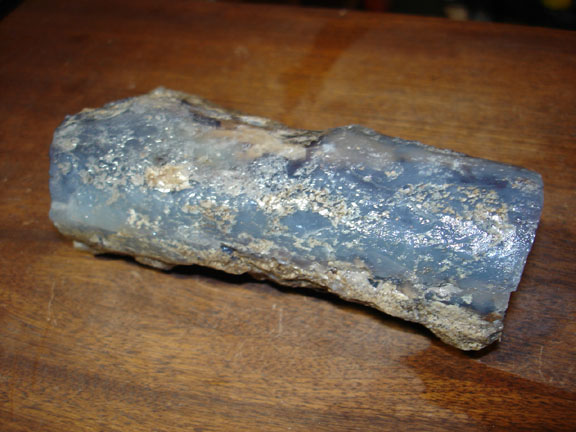 This is another Blue Forest limb self-collected. I ground off the petrified algae to show the blue chalcedony.
This is another Blue Forest limb self-collected. I ground off the petrified algae to show the blue chalcedony.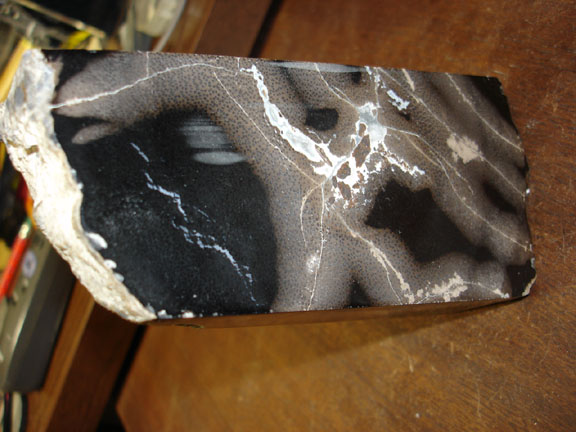 This is rather strange piece of petrified palm wood from Eden Valley Big Sandy Wash, Wyoming. It is black on one side with obvious pits characteristic of palm wood, but it is a light grey on the other side that has been cut at a difference angle of 18 degrees from this side.
This is rather strange piece of petrified palm wood from Eden Valley Big Sandy Wash, Wyoming. It is black on one side with obvious pits characteristic of palm wood, but it is a light grey on the other side that has been cut at a difference angle of 18 degrees from this side. 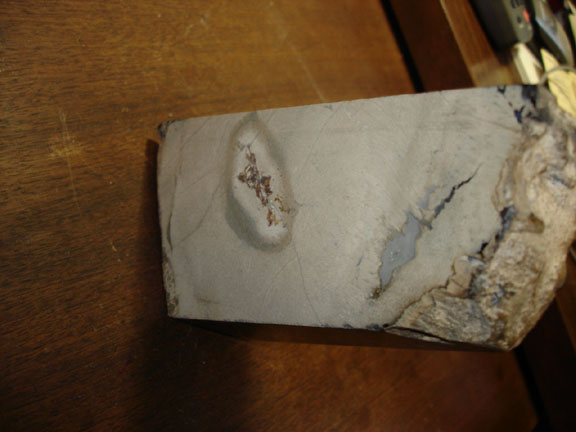 This is the other side of the same piece of palm wood. All the other sides of this piece are black except for this side. I believe this effect is the result of soaking in bleach in sunlight for a month or more. I acquired this piece from Rose’s Rock Shop in Casper when they went out of business.
This is the other side of the same piece of palm wood. All the other sides of this piece are black except for this side. I believe this effect is the result of soaking in bleach in sunlight for a month or more. I acquired this piece from Rose’s Rock Shop in Casper when they went out of business. 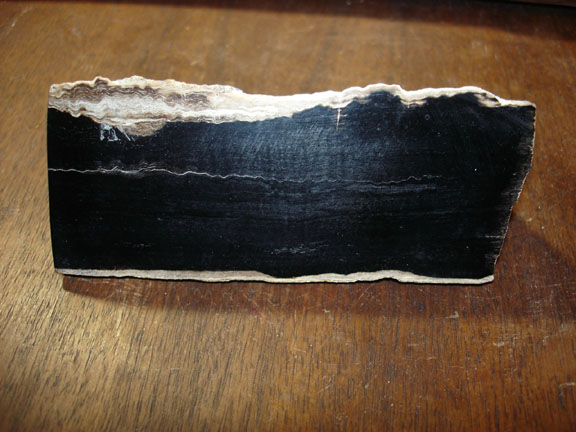 Here is another piece of wood (pepper wood?), from the Big Sandy Wash near Eden Valley. It was also acquired from Rose’s in Casper and also exhibits a strangeness. It has a shimmer when light strikes it at this angle. I tried to polish it further and it lost it’s shimmer with further polishing. I have since de-polished it somewhat to keep the shimmer. You can see some of the shimmer in the upper center of the above picture.
Here is another piece of wood (pepper wood?), from the Big Sandy Wash near Eden Valley. It was also acquired from Rose’s in Casper and also exhibits a strangeness. It has a shimmer when light strikes it at this angle. I tried to polish it further and it lost it’s shimmer with further polishing. I have since de-polished it somewhat to keep the shimmer. You can see some of the shimmer in the upper center of the above picture. 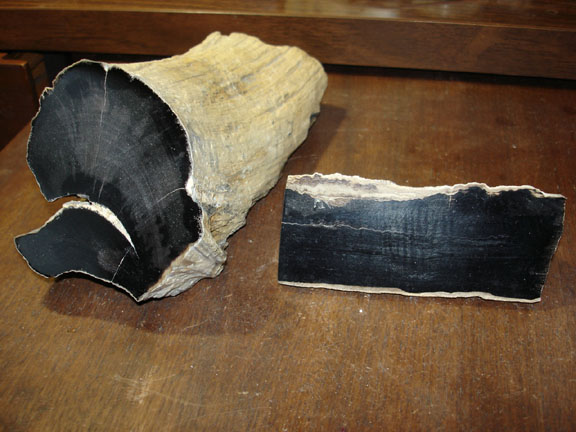 Here is a picture of the same piece of shimmering wood and a piece of Eden Valley pepper wood from the Eocene Period, about 58 million years old.
Here is a picture of the same piece of shimmering wood and a piece of Eden Valley pepper wood from the Eocene Period, about 58 million years old. 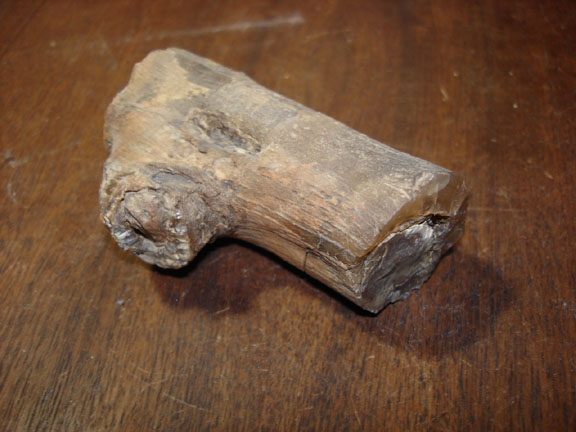 Oregon Buttes piece I collected. It is highly agatized with a nice knot and branch node. I found it under the power lines.
Oregon Buttes piece I collected. It is highly agatized with a nice knot and branch node. I found it under the power lines. 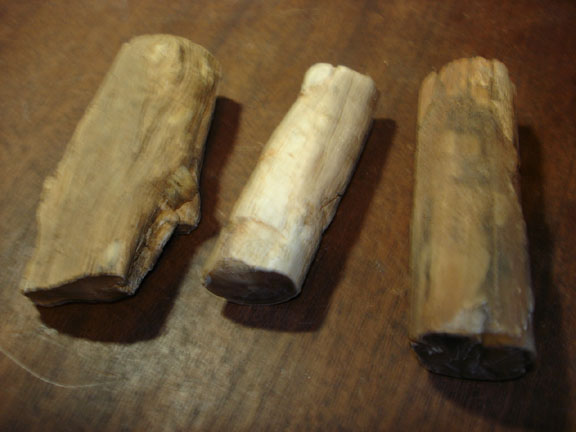 These are more highly agatized pieces I found under the power lines near Oregon Buttes.
These are more highly agatized pieces I found under the power lines near Oregon Buttes. 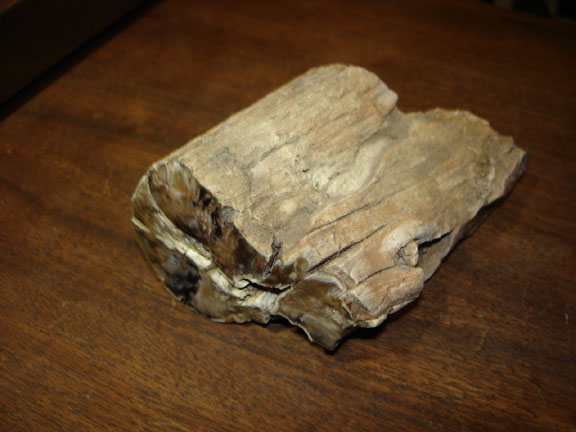 Another one of my Oregon Butte Limbs.
Another one of my Oregon Butte Limbs. 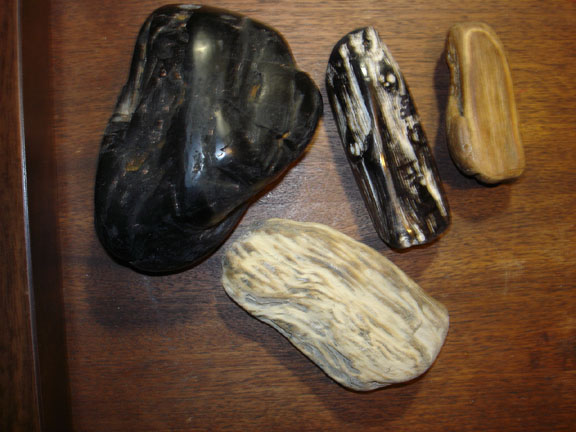 This is Montana petrified wood from the Yellowstone River gravel beds found while looking for Montana agates. It is highly agatized. I really like the black one with a white knot hole and grooves. I thought about making it a handle for a knife blade of Polar jade, but decided it is best left alone.
This is Montana petrified wood from the Yellowstone River gravel beds found while looking for Montana agates. It is highly agatized. I really like the black one with a white knot hole and grooves. I thought about making it a handle for a knife blade of Polar jade, but decided it is best left alone. 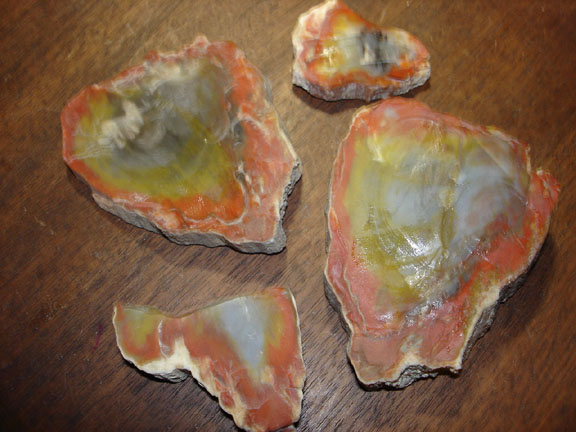 I collected this colorful petrified wood from near the Henry Mountains in Utah a few years ago. Also found a lot of Coprolite on that trip.
I collected this colorful petrified wood from near the Henry Mountains in Utah a few years ago. Also found a lot of Coprolite on that trip. 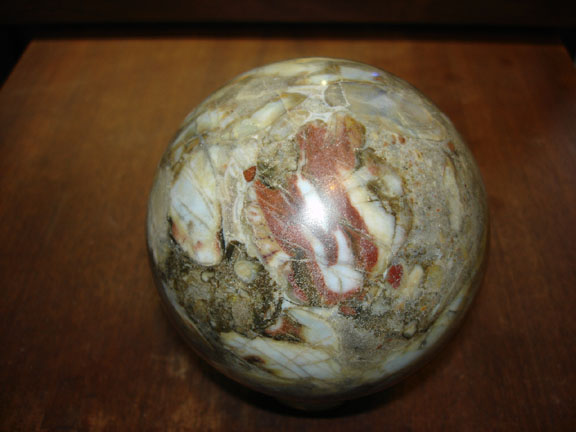 This is a sphere I made of bog wood from the same trip near the Henry Mountains in Utah.
This is a sphere I made of bog wood from the same trip near the Henry Mountains in Utah. 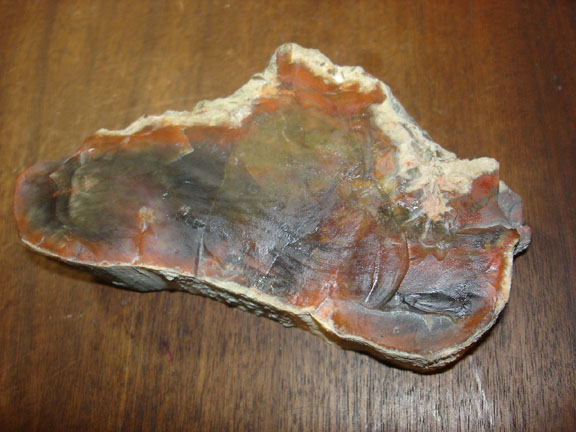 This is some Yellow Cat Wood from Utah from the same trip as the Henry Mountains.
This is some Yellow Cat Wood from Utah from the same trip as the Henry Mountains. 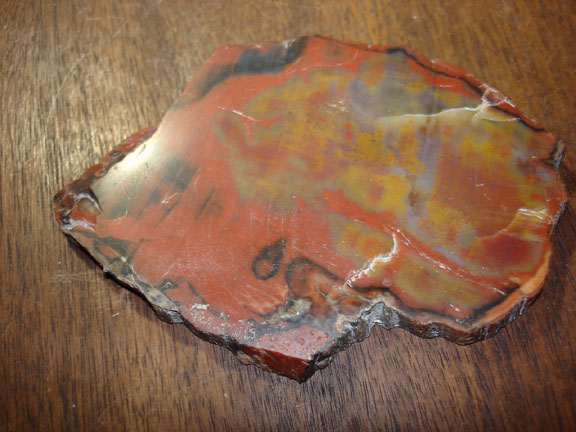 More Yellow Cat Wood from Utah I collected.
More Yellow Cat Wood from Utah I collected. 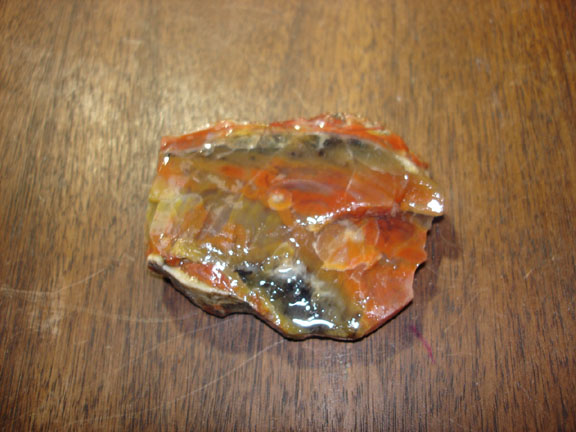 A small piece of Yellow Cat Wood self-collected.
A small piece of Yellow Cat Wood self-collected. 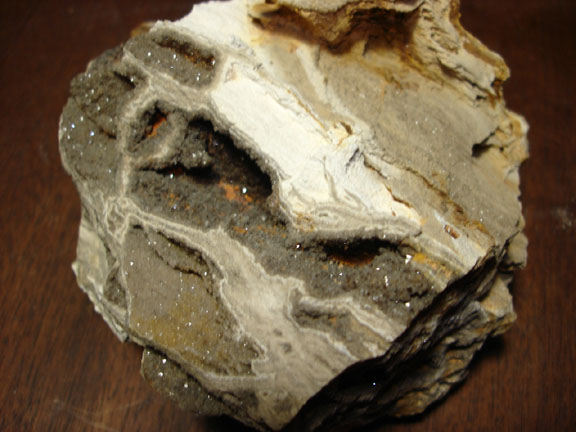 This is a piece of drussy encrusted petrified wood from northwest Alabama I acquired in a trade. It was found in Barbour County 4 miles south of Clio, Alabama. Coming from the Wilcox Group, Nanafalia Formation, Paleocene Epoch. Around 60 million years ago. The type of wood has not been determined for sure. One expert told me it is Paraphyllantoxylon alabamense. I will take his word for it. The Druzy Quartz makes this wood extra special.
This is a piece of drussy encrusted petrified wood from northwest Alabama I acquired in a trade. It was found in Barbour County 4 miles south of Clio, Alabama. Coming from the Wilcox Group, Nanafalia Formation, Paleocene Epoch. Around 60 million years ago. The type of wood has not been determined for sure. One expert told me it is Paraphyllantoxylon alabamense. I will take his word for it. The Druzy Quartz makes this wood extra special.
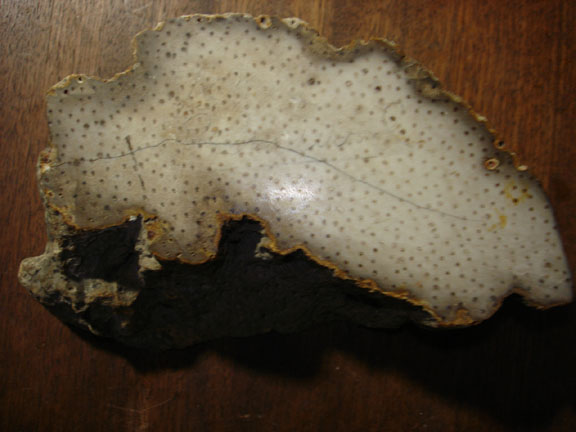 This is a piece of palm wood, probably from Texas.
This is a piece of palm wood, probably from Texas. 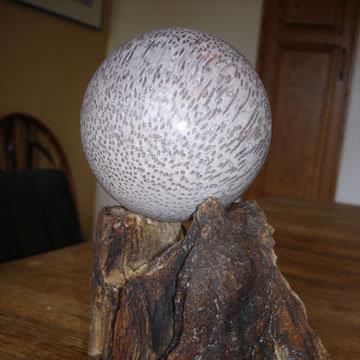 Palm wood sphere I made resting on my Suiseki stump piece from the Black Rock Desert with desert varnish.
Palm wood sphere I made resting on my Suiseki stump piece from the Black Rock Desert with desert varnish. 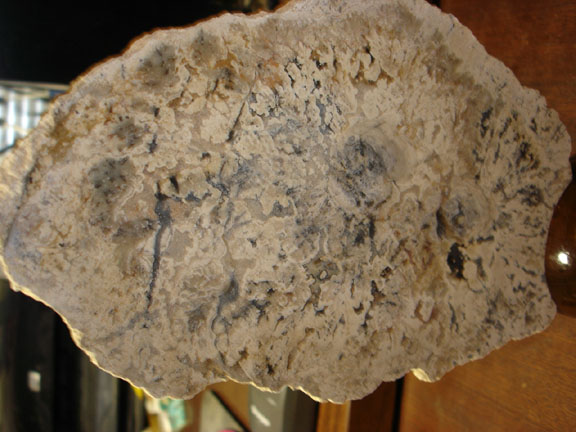 Tempska Tree Fern Slab
Tempska Tree Fern Slab 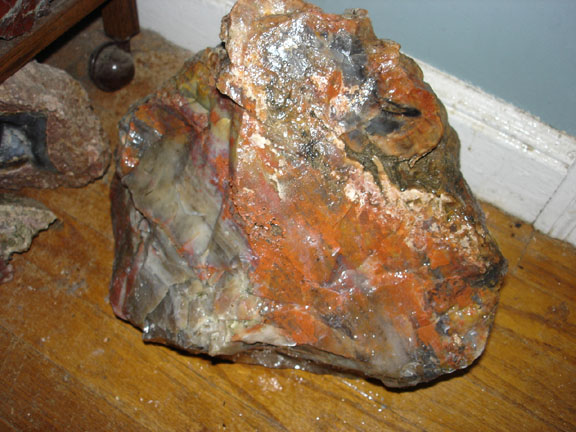 Forty pound chuck of Arizona wood from near the Petrified Forest.
Forty pound chuck of Arizona wood from near the Petrified Forest. 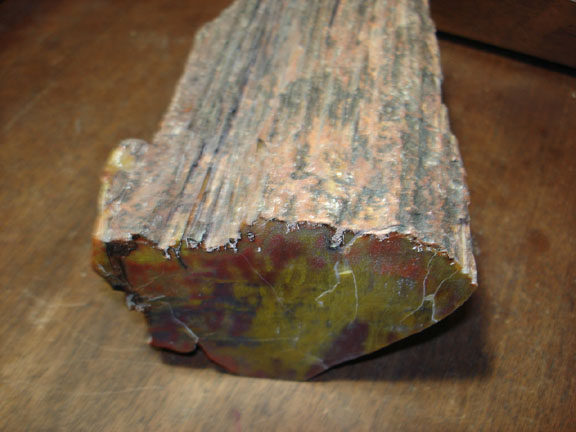 Arizona Wood, Petrified Forest, Araucarioxylon, Triassic Period, 200 million years old.
Arizona Wood, Petrified Forest, Araucarioxylon, Triassic Period, 200 million years old. 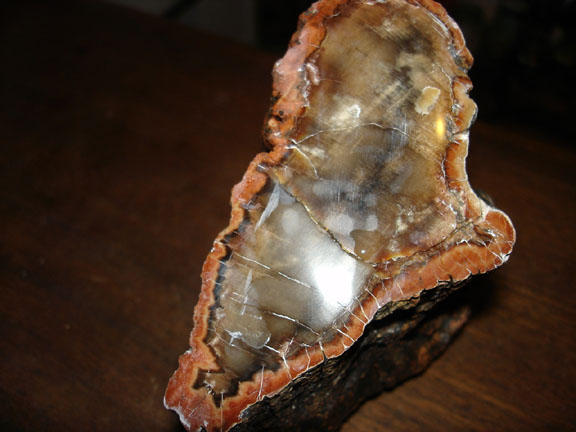 Not sure what this is, maybe monkey puzzle wood.
Not sure what this is, maybe monkey puzzle wood. 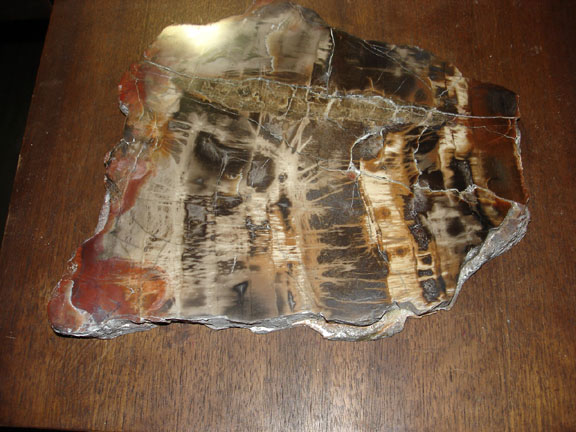 This is Monkey Puzzle wood from the Circle Cliffs Utah
This is Monkey Puzzle wood from the Circle Cliffs Utah
Here is a couple pieces of Shadow Mountain wood from Oregon collected with and from Aaron Wanner’s claim.
Roger Mtn Oregon Sequoia 15.5 million years old.
Saddle Mtn Wood Washington. Metasequoia 15 million years old.
Article on Sphere Making for Newsletters
The Fine Art of Field Collecting and Making Spheres
By Jay E. Bates
Making of spheres is not difficult but it takes large rocks and much time, usually from 24 hours to 50 hours of sawing on large rock saws and grinding and polishing on sphere machines. Softer material such as alabaster, onyx, and marble will cut faster and are desirable for first time sphere cutters. The ideal finished size for most spheres to maximize value and desirability is about four inches. Because of the size of material needed to make a sphere, it can get costly to buy all your material. Luckily you can go on SFGMS club field trips and collect large rocks that make ideal spheres.
Part One: Finding that One-of-a-Kind Rock to Make a Sphere
Some of my favorite places to search for large rocks suitable for spheres on field trips are the Monte Cristo Mountains in Nevada, Davis and Lassen Creek in California for sheen obsidian, many onyx and marble quarries and locations, and the Clear Creek area for jadeite. There are also many jasper and jasper/agate locations in many states that can also make very desirable spheres. I usually look for rocks on field trips that are about 6 inches in the minimum width and wet them down to get a good view of the colors and patterns. The farther you walk away from parking areas the more likely you are to find large enough rocks for spheres as most people are not willing to carry large rocks any distance. You should try to select a rock with a minimum of cracks and holes. However, a vug with crystals can be desirable feature for some spheres. I have also made some nice spheres from Morgan Hill Poppy jasper with cracks since the material seems to stay together while grinding even when shot through with cracks. Using such material does require the use of Opticon or similar stabilizer with rock dust of the same material before sanding. It takes a good eye to visualize a final sphere from your rock and selecting for pleasing colors and patterns makes the whole process worthwhile in the end. Some material such as sheen obsidian or star rose quartz are always desirable for spheres as you do not have to worry about orientation for optical effects since with a sphere you always get the desired optical effect on a couple sides of the sphere.
Another good place to look for large rocks for spheres is at weekend rock sales. Many times excellent material can be found at such sales at reasonable prices. Don’t be afraid to negotiate a lower price as usually the sellers do not want to end up with large rocks on their hands after the sale. Similarly, once in awhile you can score a nice rock for a sphere at the end of a rock and gem show since the dealers are reluctant to lug large rocks back to their vehicles.
Part Two: Sawing Your One-of-Kind Rock into a Cube and Later a Octadecagon
Once you get your unique specimen home you will need to wash it off and measure its least dimension to determine how big of a sphere you can roughly make. Most of you will be using the large saws in the shop. BEFORE YOU USE THE LARGE SAWS IN THE SHOP YOU WILL NEED TO BE CHECKED OUT BY AN INSTRUCTOR IN THE USE OF THE LARGE SAWS. If you bend a blade in the large saw it costs a lot of money to replace. If you do bend a blade you may have to pay for it. I am around on most Friday evenings, when I am not out field collecting, to help with sphere making. On Fridays, I or another instructor will help you once or twice with setting up the large saws until we are confident you are using the right procedures.
When placing a rock in the two larger saws place a block of wood in the vise opposite to the rock to provide a counterforce to the rock in the vise. Remember the vise acts like a teeter-totter on the connection in the middle. Use wooden wedges to get maximum grip on the rock. Finally give a yank on the rock with your hand to see if you can pull it loose before starting the saw. If at any time during the sawing you see smoke or hear a significant change in noise coming from the saw stop the saw and see what is going on. Get help if necessary.
To begin sawing first find the flattest and largest side to your specimen, make your first cut parallel to that side and as close to that side to minimize lose of material. Once that cut is made, lay the flat cut side down on the saw carriage and make the next cut on the flattest and biggest side at 90 degrees from the first flat cut side.
You will now have two flat sides at 90 degrees from each other. Keep one of the flat sides down on the carriage and the other flat side up against the from of the carriage and make another cut minimizing the loss of material but getting another side 3/4 to nearly the same size as the first two cuts.
After the third cut, get out your tape measure and measure the least dimension between either flat side and opposite sides near where the center axis of your sphere is going to be. This is going to be the maximum size your can make your sphere. Choose a size slightly less that your determined maximum size and make a fourth cut that distance from one of the flat sides with again one flat side on the bottom of the carriage and another flat side up against the front of the carriage. Keep doing the same for the last two cuts until you have a cube.
Once you have a cube you will now have to mark your cube with lines as to where the cuts are going to be made to get an eighteen sided solid (octadecagon) that can be put into the sphere making machine after some rounding of the corners. The following values are used to scribe your cube for the cuts:
W is the width of the cube. X is the distance in from an edge of the cube to where a line is scribed parallel to the edge of the cube. B is the width of each of the eighteen sides of the final eighteen sided solid. Use an aluminum scribe to scribe the lines.
W=X+X+B =2X+B X=.707B* B=1.414X W=3.414X X=.2929W
*From trigonometry for a 45 degree angle to get the equal widths on all the sides of your eighteen sided solid and a maximum sized sphere from your cube.
Original Cube Width, Inches, In Fractions of Inches
________________ ______ ____________
1.0 .29 5/16
1.25 .36 3/8
1.5 .44 7/16
1.75 .51 1/2
2.0 .58 9/16
2.25 .65 5/8
2 .5 .73 3/4
2.75 .80 13/16
3.0 .87 7/8
3.25 .94 15/16
3.5 1.02 1
3.75 1.09 1 1/16
4.0 1.16 1 3/16
4.25 1.23 1 1/4
4.5 1.31 1 5/16
4.75 1.38 1 3/8
5.0 1.45 1 7/16
5.25 1.52 1 1/2
5.5 1.6 1 5/8
5.75 1.67 1 11/16
6.0 1.74 1 3/4
Once your lines are scribed you can use either a jig or a block of wood to cut at a 45 degree angle from each flat of the cube along the lines scribed on each flat. There is a metal jig for the middle large saw in the shop and a wooden jig that can be clamped to either of the two larger saws. You can also use a plain old block of wood cut at a 45 degree angle to tilt your cube at 45 degrees to the saw blade.
Lines are scribed on the cube using an aluminum marking scribe or permanent marker.
Once your lines are scribed you can use either a jig or a block of wood to cut at a 45 degree angle from each flat of the cube along the lines scribed on each flat. There is a metal jig for the middle large saw in the shop and a wooden jig that can be clamped to either of the two larger saws. You can also use a plain old block of wood cut at a 45 degree angle to tilt your cube at 45 degrees to the saw blade. With your cube now cut and tilted at 45 degrees in the saw you now need to cut off the corners to get an octadecagon. This will take twelve cuts.
After the octadecagon is completed you will need to take it to a rough grinding wheel to round off the corners even more; in our shop that means using the 80 grit diamond wheels. Do not push the octadecagon against the diamond wheel, let the wheel do the cutting without excess force as that wears out the diamond wheels prematurely. Also do not grind on the very edge of the wheel as that can remove a strip of diamonds from the wheel.
When the corners have been substantially ground off, it is time to place the rounded octadecagon in the sphere grinding machine. We have one sphere grinding machine dedicated to rough grinding and one for sanding. There is also a dedicated sphere machine in the polishing room for final polishing. All of our sphering machines were built by Richardson’s Ranch in Oregon, who is no longer building sphering machines. I have built several sphering machines from scratch as discussed in an article in the June 2005 Rock and Gem Magazine entitled “Bates’ Sphere Machines” Please feel free to contact me if your are interested in building your own sphere making machine.
With the rounded octadecagon, in the rough grinding machine in the corner of the shop, the spring tensions need to be adjusted to get the right force of the grinding cups against the octadecagon. Also the angles of the grinding cups needs to adjusted to get the proper motion of the octadecagon in the cups. A “random walk” motion of the octadecagon is needed to get even grinding on all sides of the octadecagon. If the octadecagon does not move randomly in the cups during grinding you will only get circular grooves ground into your octadecagon. If that happens, you will need to remove the octadecagon from the sphering machine and return to the grinding wheel to totally remove the circular grooves from your octadecagon. The angle of the grinding cups is adjusted using an end wrench to move one of the grinding cups toward the middle or away from the middle of the sphere machine and tightening down the locking nut on the cup hinge when you have the octadecadon doing the proper “random walk” in the sphering cups. As you grind, you will eventually arrive with a round sphere except for some round dots. You will need to keep grinding until all the round dots are ground away. Once the round dots are ground away you have a sphere.
After grinding, the sphere is placed in the sanding sphere machine and various grits of silicon oxide are applied to the sphere with a steady water drip to make a sanding slurry. You will use coarse grit, usually 220, then 400, ending with 600, to remove all the scratches from your sphere. Adjustments to the sphering machine are similar to those you used for the rough sphere grinding machine. The sphere is then thoroughly cleaned with soap and water before placing in the polishing sphering machine for final polish. Final polish is obtained using a slurry such as water with tin oxide or cerium oxide or other similar polishing compound. Run in the polishing sphering machine until the desired polish is obtained. Your sphere is now complete for you to proudly display. Congratulations!
Going Down Big Sur
Jade Cove By Jay Bates
I fairly flew down the lightly traveled road, through the mist and scattered rain, among the resident literary ghosts imagined, going down Big Sur.
Visions of Jeffers, Kerouac, and Miller swirled; over the Bixby Bridge, beneath the forever circling giant condors; an interlude at Pitkins Curve Bridge and the massive construction of Rain Rocks rock shed.
“And here the heavy future hangs like a cloud; the enormous scene; the enormous games preparing. Weigh on the water and strain the rock; the stage is here, the play is conceived; the players are not found.” visions of Jeffers unbound
The fog bore down on the pendent cliffs, as if whispering follow me, follow me into the breaking surf, but the mountains stood firm with their aerie crests, but for an occasional rolling rock; and I drove on.
Rounding a curve, I passed a plain sign, “Jade Cove” I had arrived. Slowly circling I found my assigned camping spot and backed in, found my friends and headed for the cliffs.
So here I was at Jade Cove and soon clambering down the cliffs on a juted frayed rope, tempting the jostling waves, fearing a rogue wave; digging and moving rock in the tidal zone.
Tiny bits of apple green jade glistened among the sand fleas, and lots of pretender serpentine and jasper among the flotsam and jetsam. Is this jade, Harry? No way, keep looking Jay.
Soon storm clouds moved in and we beat a hasty retreat up the slippery sliding cliff face and back to our vehicles and prepared for the long oncoming stormy night.
Around midnight, I awoke to the heavy tattooing of hard-driven rain on the rooftop of my battered Jeep. I tried the earplugs, without much success. I laid there in the total darkness remembering;
Boy he must of gone crazy out there. Ah but they’ve never seen the northern lights, they have never seen a wild grizzly, They’ve never seen a giant condor on wing, They’ve never seen the sights atop Mount Rainier.
Slowly the dawn burned bright and the mountain tops glistened with fresh fallen snow. Is this not a special place with snowy peaks and thundering breakers on towering cliffs? I must be crazy to keep going outback. I hope it doesn’t show.
We drove beneath one of the numerous bridges on Route One built when men dared to gouge a road from the mountainside above the surf. Now they work painfully slow, to keep the sea and mountain at bay so we mortals can fly down the wild coast.
Out into the tidal zone, ever vigilant for rogue waves, we walked among the boulder stack looking for diopside with streaks of jade, I found some jade. My eyes were calibrated at last. A few precious pieces to remember another trip outback.
Back in camp I met a local jade diver who showed us some beautiful blue jade and some outlaw gold dredgers who had their dredge destroyed by a jade diver from Carmel. Yes, the play conceived, the actors found, and conflict unbound.
The breakers bore in, the mountains continue their slow rise and crumbling into the sea inordinately on conflicting tectonic plates, oblivious to the puny plays and conflicts of man.
Sand fleas in an enormous game. Another momentous trip into the outback, and some jade at last
The Tale The Bottle Told
This is a copy of my Grandfather’s poem I copied word for word as he had written it on a piece of stationary from the Queally Land and Livestock Company. One of my cousins have previously had it published in Laramie Wyoming by a local company.
Queally Land and Live Stock Company
Stock Raising
The Tale The Bottle Told
By Jay L. Johnson
A drink. No thank you pard
Though to refuse comes pretty hard
For I have been in the toils of Demon Rum
And to answer no bothers me some
I will tell you a story, this a tale a bottle told
Of an old range pal, who has passed into the fold
We were riders, and he and I
Were punching cows for the lazy Y
The boys all called him Sunny Jim
I go by the name of Rawhide Slim
When we all got peeved, sore and riled
He took things cool and I joked and smiled
Out on the round-up when it rained a spell
And we all rolled out at the daylight yell
Grumbling and cussing a puncher’s life
Jim would be cheerful mid all the strife
But Jim must have his periodical
And that no doubt made him a prodigal
For all of us boys could tell by his ways
That in his past he had seen better days
After the fall round-up and the beef were in
Winter settled down and it snowed like sin
Out to the line camp at Teepee Ring
Went Jim and I to ride fence till spring
The nights were long, the days passed slow
And Jim began to talk of the Bow
I could tell by that and other sign
That he was hearing the call of the wine
We rolled out one morning, twas cold and bright
And Jim allowed he would go to town and stay oer night
He saddled up his black horse Joe
And hit the trail for Medicine Bow
Along in the night it began to blow
And soon the air was filled with drifting snow
Blast after blast came swooping along
And the wind kept howling its dismal song
The second morning dawned calm and clear
And I kept watching the trail for Jim to appear
And when by noon he did not show
I saddled up and pulled for the Bow
Twas mighty hard going the drifts belly deep
No sign of a trail for the horse to keep
And where the trail joins the road for the stage
I found Jim’s horse, reins caught on a sage
And as my gaze swept oer the broad field of white
I knew that Jim had become lost in the night
Then I rode round in circles and covered the ground
Until at last poor Jim’s body I found
As I sadly looked on his cold white face
I fancied I could see of his old smile a trace
An empty bottle he held in an icy clutch
Lying there dead still in youth it was too much
And as I turned away my heart filled with pain
I swore to never touch liquor again
For an empty bottle, stranger told the tale
Of a true friend and pal lost on the trail
It was just another tragedy of this life we live
Just another case of weakness and the price we give
And as I live through the years and grow old
I will never forget the tale that empty bottle told
Jay L. Johnson
Down the Dusty Road
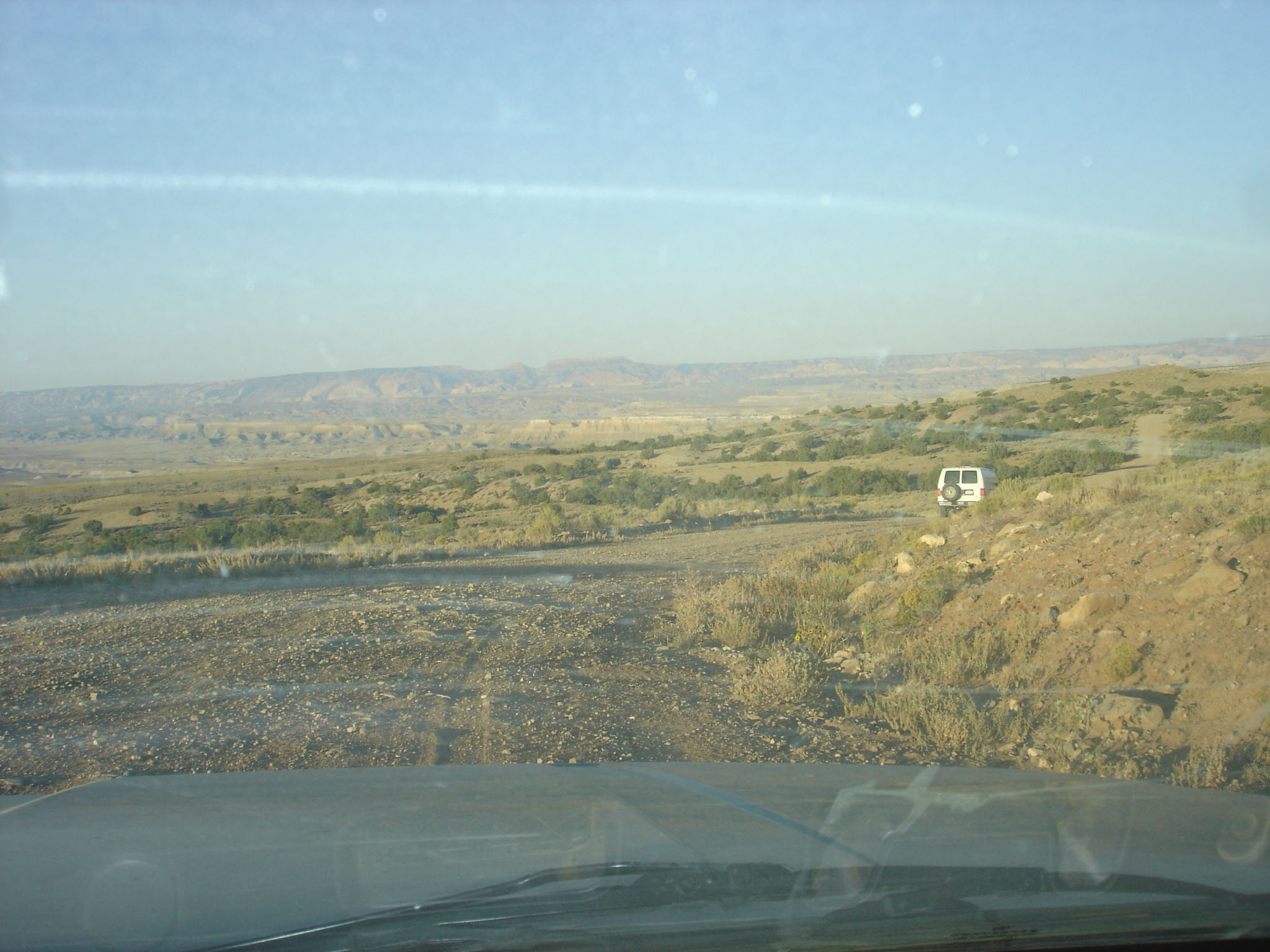 Down the Dusty Road by jay bates
Down the Dusty Road by jay bates
It is always said,
Behind the mountains are more
Mountains and mountains
Beyond the Escalante
Into the Waterpocket Fold
Mountains and ghostly shore
Down the dusty road
From the Henry’s
Into Jurassic time not told
There lies petrified wood and coprolites
And now a whole tree protrudes
From the days of dinosaurs and trilobites
Down the dusty road
We are awed by thee
We beings of unjustified vanity
The Z Tractor
It was a tractor of simplicity itself.
A magneto, gravity flow fuel and a crank
Mostly used as a cultivator
It started easy enough when cold
You did not want to stall it hot
For it would not start how much you cussed and sweated
A long day in the Colorado high plains sun
With a straw hat donned
The noise and vibration continued after shutdown and remained for awhile
Long rows or pinto beans, beets, and corn
Blue skies and unrelenting sun
The canvas water bag caked with damp dust
Thirsty and hot is the boy
Longing to take a dip in the nearby irrigation ditch
But, he sighs, and settles for a long drink on cool slightly dust tasting water
Somewhere some boys are swimming, fishing and having fun
Not today for the farmer’s son is resigned to the monotonous rows and bright sun
He knows tomorrow will bring more of the same and the Z will continue into his soul to run
Fire On the Mountain
FIRE ON A MONTANA MOUNTAIN Jay Bates
The call came in while we were out marking timber
Fire on the mountain, near Wolf Creek . A night to remember
We loaded in the Jeep with pulaskis and shovels
Not a minute to spare, we sped on like avenging angels
Out of the dark loomed an entire mountain glowing red with burning trees
We started up the mountain, a ragtag crew of twenty three
Halfway up we stopped to rest in the eerie red glow
And old Rodger told his tale of a young man, long ago
He had been on a smoke jumping crew in 1949 out of Mizzo
Fire, at the Gates of the Mountains, not far from where we were, we knew
At the last minute he was called back to pack chutes and off flew the plane carrying the rest of the crew
That night they jumped into history and legend as ten died the next day when the fire built and roared anew
At the end of the summer Rodger quit smoke jumping as he had known young men that died
And although he continued to battle fire, he didn’t like it, and knew the bravado of young men, he must abide
As a nearby tree torched with a roar, we were brought back to reality and knew we were in for a hot time
We callow young men of varying degrees and old Rodger were there to build and hold the line
To hold back the greedy flames and save Montana, one more time.
Oh you young men and women now sent out on fire, please heed the words of old Rodger
For no number of trees is worth another funeral pyre
Of callow young fellows on a monstrous Montana fire
My Secret Life
My Secret Life By Jay E. Bates
Now that I have been retired for 15 years I can divulge some of my
previous government employment secrets. At one time, in the sixties, I
was employed by the Advanced Research Force to develop a super dog that
could detect any lies or inconsistencies in peoples statements. We were
headquartered in an old farm house in Kansas know as Area 9.
In the 19th Century, dog breeders invented all sorts of highly useful
breeds. Since that time dog breeders have mostly done nothing but make
more adorable the existing breeds. What kind of breeds would be useful
in the 21st Century? In one of my more lucid moments, it struck me that
maybe somebody could breed a canine assistant, a dog with such a refined
sense of smell and of detecting human body language, they could detect
whether a person was lying or stretching the truth and would bark
accordingly. I put together a prospectus of my proposal for the
Department of Good Products of Outstanding Potential (DOGPOOP), which was readily accepted.
In due course, we had inter-bred many varieties of the more intelligent
working dogs and produced a super dog, Combined Ultimate Retriever,
or CUR for short. This beast could detect the slightest hesitation or catch
in the voice or a slight movement of the eyes that was a tipoff of any
stretching of the truth. We soon had a pack of these useful animals
ready for the super-secret group known as Bureau Investigative Technical
Cryptological Happenings.
We were very proud of our accomplishment, as you can well imagine, and
decided to show off the CURs to the Senate Intelligence Sub-Committee behind
closed doors in a secret meeting. Everything was going well with all the
CURs behaving themselves as we make our presentation to the
sub-committee. The sub-committee sat there is rapt silence, stunted by
the brilliance of our efforts. At the close of our presentation, the
distinguished head of the Senate Intelligence Sub-Committee, a well
known Senator known for his appreciation of good
liquor and young ladies , rose to his feet to thank us and heap
accolades upon our heads. However, as soon as he opened his mouth, all
Hell broke loose, with the whole pack of CURS howling and barking at the
top of their lungs. Needless to say, that was the end of our project.
All funding was ended and we were banned from any further government
contracts.
Now you may think that is the end of my sad story. However, unbeknownst to
us there had been a Russian double agent employee of the Senate
Intelligence Sub-Committee working as a doggerel interpreter. She had
passed on our secrets to the Russians, and their secret group,
Proletariat Order of Committed Heroes. In due order they had produced
their own super dog known as Fierce Interceptor Defective Observations,
or FIDO for short. Now the Russians did not have any such silly thing as
a legislative oversight committee, so they were able to complete their
project and produce a whole series of FIDOs for all the members of the
Politburo. Now you all know that a distinguished member of the
Politburo does not stoop so low as to feed his FIDO, and as you might
have suspected as least some of the Politburo members wives ended up
feeding the FIDOs. Once the FIDOs had become the used to the women
feeding them, they naturally accepted the wives as the alpha member of
the pack and began ratting out the Politburo members and their dirty
little secrets. Also members of the Politburo’s select few were
beginning to detect lies and distortions among their contemporaries. As
you can well imagine that was the beginning of the end for the Union of
Soviet Socialist Republics.
Now you all know that while our esteemed former President Reagan may
have gotten most of credit for the end of the Russian Empire, the real
reason shall for ever always be buried like a bone, because of
catastrophic consequences to world harmony and everyday discourse if
ever such a secret weapon such as the CUR or FIDO be unleashed on
mankind again. Thank God for Congressional Oversight Committees!
Down All the Days
Down All the Days By Jay Bates
The mist hung on the hills, wafting in a cold wind blowing down the Diablo Range. We four huddled around our screens and kept moving to hold the in-creeping cold at abeyance. We were screening for that mythical gemstone benitoite. We were washing the dirt off tailings at the Gem Mine in hopes of a facetable stone.
Some weeks before we had been there on a warm and sunny day, basking in the warmth and the aroma of the surrounding incense cedars. It seemed much easier then to find those little electric blue crystals. Now it seemed they had all disappeared. Still, we soldiered on, for we knew not when we may be able to return to this remote location or whether we could even return to the land of Happy Meals over the sodden dozed tracks laughingly called roads on the maps.
The wash water ran out, so Dave and I put his hitch on the back of my Jeep and trailed the water tank trailer down to the creek bottom to pump it full from an underground tank placed there to collect water during to oncoming threatening winter rains. Now in four wheel, I crept back up the pit tracks to the top pulling a ton and half of wash water. All for a tiny blue speck that resembled a bit of blue glass, you would not think twice about picking up on the street.
But we had a bit of good luck! While busy getting the wash water, Bob had done a little sniping around a tailings pile and found some undamaged included crystals of pinky nail size. Not gem quality, but what awesome specimens they are! Maybe Big Ernie was going to be kind after all as a glint of sunlight pierced the mist. No, it wasn’t going to happen, as the mist again closed in and we returned to our dreary screens. Slowly moving with buckets from the coyote hole to the screens on the slippery slopes. Dump, wash, swirl with numb fingers, and now squint with a hopeful eye for that electric blue vision. No, none there. Keep moving. Maybe the next bucketful will reward us for our efforts. Harry and Mary had given up on their singular efforts of moving large amounts of material looking for larger gems and had joined us manning the washing screens looking for any stone justifying our insane efforts. Mary, with an eye of an eagle, was having no more luck than the rest of us. All for naught, on a cold misty drizzly slope.
These hills, wrought from the earth on sliding tectonic plates, have always been realm of the desperado and wild beast; and a man there is always alone. Once it was where bears the size of kodiaks roamed. It is still the home of giant condors, wild boar, and lion; and a man there is always alone. The wild-land firefighters hate the hot burning impenetrable chaparral. The EPA has banned man from the largest asbestos areas known to exist. But there still are those that find solitude in the Elfin Forest and Serpentine Barrens and the hot dry slopes of pines and cedars. Maybe, with a little luck, a glint of electric blue, on some future warm summers day. Not today, anyway, you miserable fool!



